

| Trade log-in: | HERE | |
| Get password | Forgot password | ||

2015.3 | 2015.2 | 2015.1
2014.3 | 2014.2 | 2014.1 | 2013.3 | 2013.2 | 2013.1 | 2012.3 | 2012.2 | 2012.1
2011.3 | 2011.2 | 2011.1 | 2010.3 | 2010.2 | 2010.1 | 2009.3 | 2009.2 | 2009.1
2008.3 | 2008.2 | 2008.1 | 2007.3 | 2007.2 | 2007.1 | 2006.3 | 2006.2 | 2006.1
2005 | 2004 | 2003 | 2002 | 2001 | 2000
 |
Pala International president Bill Larson will address the 2010 Tucson Meeting of The Society of Mineral Museum Professionals on the subject of Gem Crystals – Mogok, Burma. The meeting will be held during the annual extravaganza of gem and mineral shows in Tucson in late January and early February. The public is welcome to attend.
The Society of Mineral Museum Professionals (SMMP) is an international organization of mineral museum curators and others with related interests. SMMP is a non-profit, tax-exempt corporation incorporated under the non-profit laws of the State of Arizona.
Event: SMMP 2010 Tucson Meeting
When: Thursday, February 11, 4–5 p.m.
Where: Tucson Convention Center
After the holidays, we’re looking forward to the world’s greatest gem and mineral show in February. One-stop general information about individual shows can be obtained from the Tucson EZ-Guide.
Pala International will be represented in Tucson as follows. We look forward to seeing our many friends there. Visit the Pala International Show Schedule for future events.
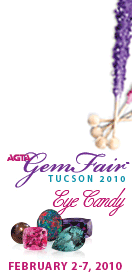 |
Pala joins nearly 100 exhibitors for this annual extravaganza. Some highlights from the schedule that may interest mineral lovers and dealers:
Event: AGTA GemFair
When: February 2–7
Where: Tucson Convention Center
Pala International Booth: 1016–1018
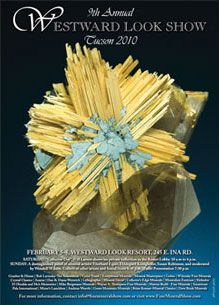 |
Pala International and two dozen other world-class mineral dealers shack up at a Sonoran Desert resort.
Event: 9th Annual Westward Look Mineral Show
When: February 5–8
Where: Westward Look Resort
Pala International Suite: 236
See Pala International’s page on the Westward Look Show site.
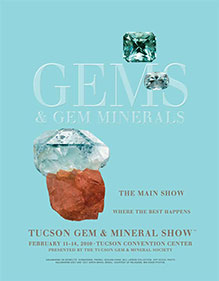 |
TGMS is the largest gem and mineral show in the country. This year’s theme is “Gems and Gem Minerals”—a Pala International specialty.
Event: 55th Annual Tucson Gem and Mineral Show
When: February 11–14
Where: Tucson Convention Center
Pala International Booth: Aisle 5 East
Ronald Ringsrud has informed us that the Geo-Literary Society will host a book signing (Emeralds, A Passionate Guide) and lecture by Ringsrud in the Crystal Ballroom at the Tucson Convention Center during the TGMS, Friday, February 12, at 3:30 p.m.
The next day, Saturday, February 13, Richard Wise will appear at TGMS at 11:00 a.m., with a signing (The French Blue) and talk on “The History and Mystery of the Hope Diamond.” [back to top]
The I-10 Widening Project is complete; therefore the Gem Ride shuttle is discontinued. Many shows, however, will offer their own shuttles. View your transit and parking options here. [back to top]
Hammering, drilling—the high-pitch construction noises swirl around my ears as showcases and displays are set up. A construction painter colors the INDIEN archway green to match the theme of the exhibit. Set-up was going smoothly Tuesday, the 27th of October. The floors were empty of clients and collectors, an eerie feel to a place normally so crowded. But the cavernous spaces still crawled with a few eager dealers; passions outpoured on as a few people fought over who could see what first. Like the last lollipop in the candy bowl from childhood, years later the same tactics apply!
So begins Will Larson’s report on this year’s Munich show, Mineralientage München. Read the full report here.
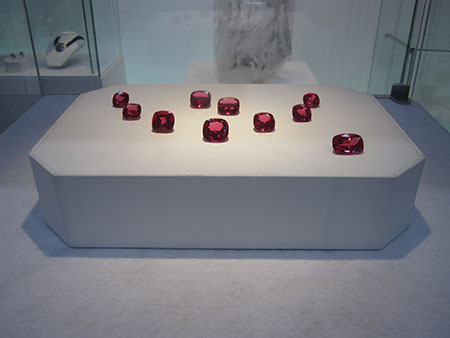 |
| Other facets of Munich. Many fine gemstones were on display at Munich. Above: Tanzanian spinel. Below: Corundum—sapphires and rubies, stars and faceted. (Photos: Will Larson) |
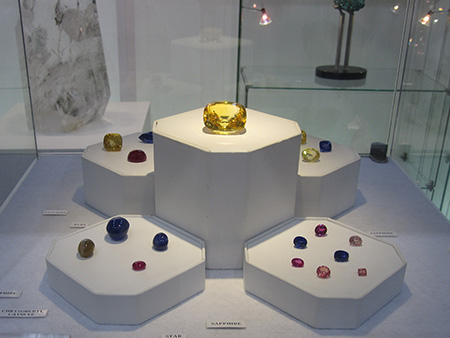 |
[back to top]
This month Pala features what has become a rare commodity in the colored stone world: a large, fine spessartite suite consisting of 17 well-matched mandarin colored garnets. This set graduates from 8 x 7 mm. ovals to 12 x 10 mm. ovals, which are set off by a pear-shaped center stone measuring 14.6 x 12.5 mm.
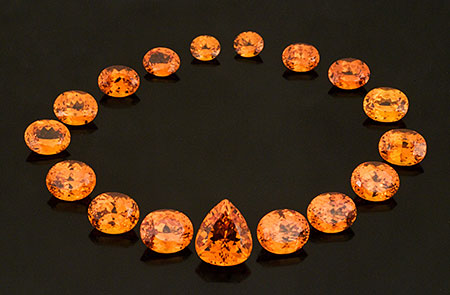 |
| Spessartite suite: Inventory #16390. (Photo: Mia Dixon) |
Larger spessartites with exemplary orange color such as these have become increasingly rare as the inventory of fine Nigerian material disseminates amongst connoisseurs. With the deposit in Nigeria being out of production for a few years now, and the new Tanzanian material being heavily included and found in smaller sizes, the supply chain has been cut off. This colorful suite may be one of the last great assemblages of the fine material we have all come to know and love from Nigeria.
Interested? Select the inventory number above, call, or email us to inquire. See also our Spessartite Buying Guide. [back to top]
 |
Lawrence Hess has been appointed executive director of the Plumb Club, the elite industry organization of manufacturers “with the common denominator being ‘best in class.’” The announcement was made in late October, and carried by news outlets such as National Jeweler. Hess somewhat follows in the footsteps of his father, Jose Hess, a founder and past president of the group.
Hess has 25 years of industry experience, and so it may not easily be recalled that he once had an association with Pala International and The Collector Fine Jewelry. The Collector’s Jeanne Larson recalls: “I had a wonderful relationship with his father, Jose, through The Collector Fine Jewelry. Lawrence went to GIA and upon his completion of the GG diploma, I offered him an internship in my La Jolla store. It began in June of 1983. He worked in the store under manager Anne Halsey. He then transferred up to Pala International [in Fallbrook] and worked there” until September of 1985.
Pala VP Josh Hall remembers: “Lawrence was here to learn about the mining and the sorting, grading, and pricing of high-end colored stones. We also made him work in the booth at shows, just to get some revenge since we knew his time here was limited. All of us here at Pala wish him much success and a long tenure.”
As the Plumb Club’s first-ever executive director, Hess will be responsible for development of added value for club membership, including the building of a new Plumb Club Pavilion that will debut at JCK Las Vegas in 2010—expected to be one of the largest in North America. [back to top]
While it may be overlooked during the holiday bustle, the season leading up to Christmas, known as Advent, actually has a penitential aspect. Purple may be seen amid the red and green, and liturgical ministers are advised to observe decorum. As explained by a Roman Catholic guidebook, “[T]he organ and other musical instruments should be used with a moderation that is consistent with the season’s character and does not anticipate the full joy” of the Nativity.
Thus we can recommend without reservation Sacred Spain: Art and Belief in the Spanish World, imagery of Passion (and Glory) designed for devotion and introspection—imagery that once might have been considered idolatrous. The exhibition, at the Indianapolis Museum of Art, will not travel, and must close on January 3 so that its treasures can be returned to the parish churches from which many have been lent—for Lent.
A rarely exhibited centerpiece of the exhibition, the Crown of the Andes, will be returned not to an ecclesial community, but to a private collector…
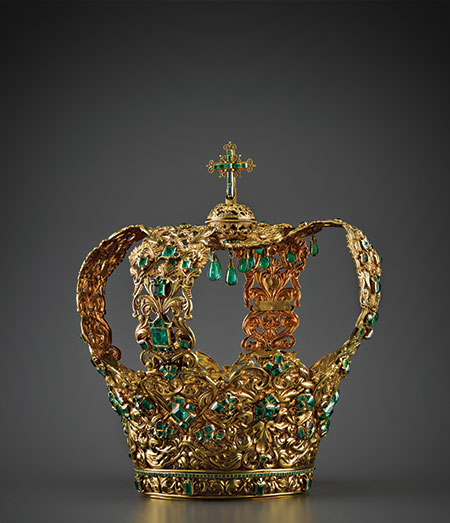 |
| Crown of the Andes. Gold, cast, repoussé, and chased, with emeralds, 13.5 in. high, 13.25 in. diameter. (Photo courtesy Indianapolis Museum of Art. |
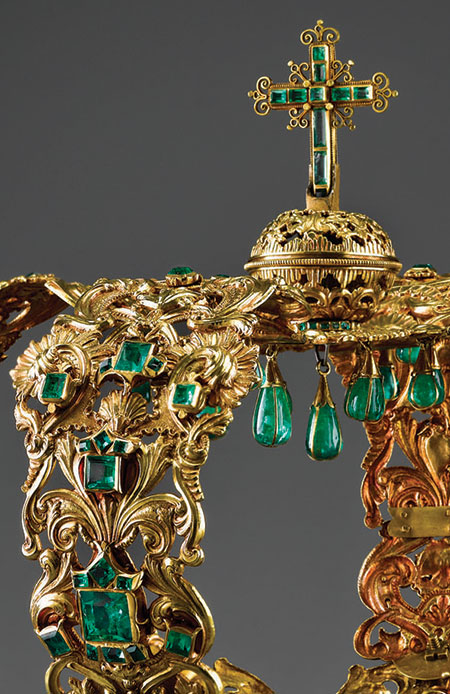 |
In his book Emeralds, A Passionate Guide, Ron Ringsrud recounts the story behind this exquisite diadem, which took “six years of labor” to complete. It was fashioned from material donated by parishioners of the colonial town of Popayán, in western Colombia. As a trade crossroads, the town would have been expected to be decimated by plague when the disease ravaged the surrounding area in 1590; but the town was spared. Divine intervention? Of course, and it was to be reciprocated with the creation of an image of Our Lady, lavishly invested.
According to Ringsrud, “over 100 pounds of gold and 447 emeralds weighing 1521 carats were donated.” We’ll leave you to consult Ringsrud regarding the crown’s eventual transfer into private hands, but the “jewel” amongst jewels in the crown has its own story: the 46-carat emerald (shown above) is said to have been seized from the Incan monarch Atahualpa, in 1532, as part of his ransom to the Spanish conqueror Francisco Pizarro. (The ransom notwithstanding, Atahualpa was killed by Pizarro, who in turn was assassinated by the mestizo “El Mozo”—Diego de Almagro II—to avenge the death of his father.)
Ringsrud:
As a religious icon, as a magnificent creation of jewelry, and as a display of emerald color and clarity, the Crown of the Andes is many times treasured. It can only be hoped that this fine rarity will surface again and bless the crowds with is regal religious power.
Happily, that day has come. [back to top]
If the idea of an a Midwestern sojourn gives you the chills, how about Southern California? Southland denizens will have two chances this week to meet Ronald Ringsrud, author of Emerald, A Passionate Guide, at Nevada Mineral & Book Company, 342 S. Tustin Street, Orange, CA 92866.
In the spirit of the season, a raffle will be held each day for a half-kilo of Colombian coffee beans that Ringsrud will bring back from his December trip to the Bogotá emerald market and Colombian emerald mines. Mineral specimens of emerald will be on display and for sale. Colombian coffee will be served.
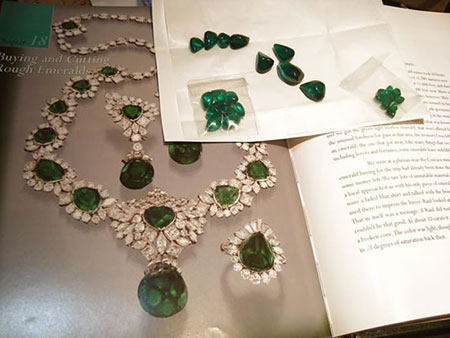 |
| Spanish Drops. As is pictured in the title photo in Chapter 18 of Emeralds, A Passionate Guide, these Spanish Drops are back in fashion as a magical way to exhibit the fine color and exquisite inner nature of these Colombian emeralds. Ringsrud will have emerald mineral specimens on hand for display and sale at his Southern California appearances this month. (Photo courtesy Ronald Ringsrud) |
[back to top]
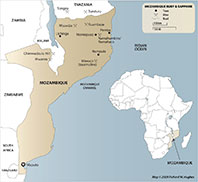 |
| Ruby and sapphire localities. Click to enlarge. (Map: Richard W. Hughes) |
For the last two years, rubies from northern Mozambique have created a stir in gem markets from Tanzania to Thailand. Stirred also are the passions of gemologists to visit the localities producing these gems.
Earlier this month, after two previous attempts, Vincent Pardieu was successful in visiting new ruby mines in the northernmost province of Cabo Delgado, near the town of Montepuez, about 200 kilometers inland from the provincial capital of Pemba. Cabo Delgado is where the Portuguese colony’s ten-year struggle for sovereignty was launched, and once gained in 1975, the country was embroiled in twenty more years of civil war, fomented by foreign and displaced elements. So perhaps it’s not surprising that in September, in neighboring Niassa province, Pardieu’s first attempt to visit that ruby mining area would be met with a “misunderstanding”—leading to his party’s arrest and release after three days’ detention. A proposed visit to the mines of Montepuez was nipped in the bud a few days later when Pardieu was told the political situation during the presidential election season precluded their plans.
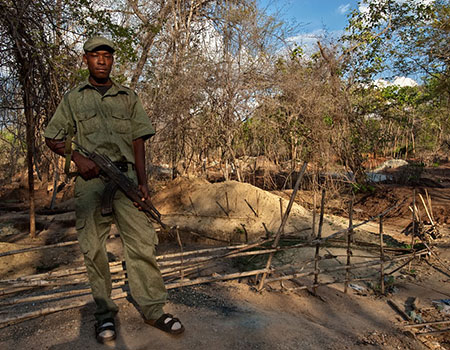 |
| En garde. A soldier stands before the ruby mines near Montepuez. (Photo: Richard W. Hughes, Ruby-Sapphire.com) |
Wasting no time, on the day before the election, Pardieu returned to Mozambique—solo this time—and nine days later was successful in visiting the Niassa mining site, in the Niassa National Reserve, one of the largest reserves in Africa, occupying 42,400 square kilometers in the north-central area of the province. Pardieu identified two types of deposit before barely outmaneuvering heavy rains. (Read the full story on FieldGemology.org.) A visit to Montepuez still was not in the cards, however.
 |
| Mineral and metical. Ruby rough from Montepuez lies next to a 10-metical coin (diameter 26.75 mm.). (Photo: Richard W. Hughes, Ruby-Sapphire.com) |
In early December, Pardieu returned to Mozambique again, this time as a presenter at the annual congress held by the Mozambique National Reserves. Also at the conference was the manager of the company that holds the rights to the Montepuez mining operation. An expedition was arranged, and Pardieu, along with gemologists Richard W. Hughes and Mark Smith, were to be “the first foreigners to be allowed to visit this very promising new deposit.”
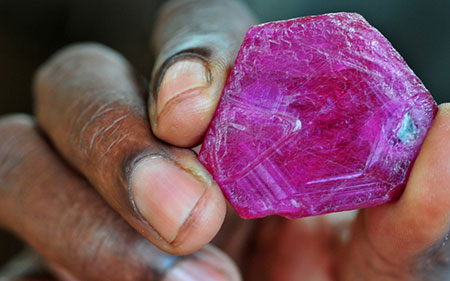 |
| Compare and contrast. Pardieu on Montepuez ruby: Above is a “40 gram stone, showing some silk quite similar to what can be found in some Burmese rubies.” Below: “This is the best ruby I’ve ever seen visiting a mining area: around 10 carats rough, a clean stone with just a few needles and a small crystal inclusion (possibly amphibole).” (Photo: Vincent Pardieu, FieldGemology.org) |
 |
Today, as we went to press, Pardieu compared for us the material from Montepuez with that of Winza, in Mozambique’s northern neighbor, Tanzania (see our “Vince’s Winza,” February 2009):
Such exceptional stone is in fact a byproduct of mining for material suitable for lead glass and flux type treatment, as without these treatments the miners would not find a market for their stones, and thus would soon stop working. This is what happened in Winza: first everything was selling; there were then several thousands of miners, then the buyers found out that the low quality material was not suitable for heat treatment [the blue color zones did not respond to heat]. Dealers refused then to buy it or were giving prices far to low for the miners to survive. The mining production then dropped dramatically as most miners left the area. In Montepuez it is different: all the material can find a market; thus this mining area has probably a much brighter future... Maybe a new Mong Hsu-like story? Who knows?
The story of this latest excursion was published today on the website of Pardieu’s employer and sponsor, Gemological Institute of America Laboratory Bangkok. Pardieu tells us that articles on the mines are forthcoming in ICA’s InColor and GIA’s Gems & Gemology.
A September 13 update of a March 22 report on rubies of the region also is available.
Pardieu’s three-day detention at Niassa—with fellow gemologists Lou Pierre Bryl, Stephane Jacquat, and Jean Baptiste Senoble—provided time and space to consider the context within which so many African gemstones are mined, namely, nature preserves such as those at Niassa and the Tsavo National Parks made famous to gemstone enthusiasts by the late Campbell Bridges. An outgrowth of those ruminations is the (now-under-construction) blog ConservationGemology.org, which will discuss the intersection between gemology, preservation, and eco-tourism. [back to top]
A prominent Yangon hotel, the Kandawgyi Palace, is slated to feature a year-round gemstone exhibition, according to a Xinhua story December 2. The intent is to “attract more visitors to the country as part of its bid to boost both the gem industry and the tourism industry,” according to hotel sources contacted by the news service.
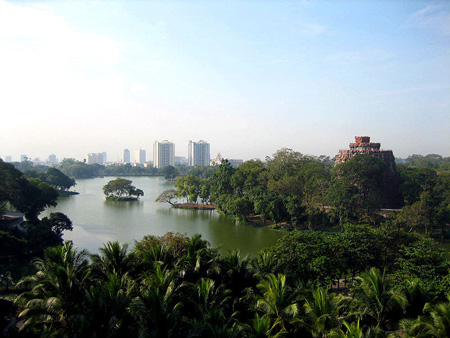 |
| Royal lake. At the southwest corner of Kandawgyi Lake is the hotel (not pictured) that bears its name. This artificial reservoir dates from British colonial times and is surrounded by acres of parkland. (Photo: Wikipedia) |
An incredible 60 showrooms will be devoted to the permanent exhibition, which is scheduled make its debut early next year. “Gem-related training” is to be conducted, but who would receive the training was not mentioned.
The hotel’s Bangkok-based management group, which has Chinese investors, also operates the Baiyoke Sky Hotel, Thailand’s tallest, according to The Irrawaddy. [back to top]
The Xinhua story above also released figures for the 18th Mid-Year Myanma Gems Emporium, which earned $120.5 million (€96.46 million). The sale, which was held October 25–November 6, offered 8,140 jade lots, 223 lots of gems and jewelry, and 270 lots of pearls. About 2,000 foreign gem merchants attended, according to the article.
The results put quite a snag in a generally level-to-upward trend seen in past biannual sales. Last year’s fall sale brought in about $50 million more in proceeds, at $175 million. This figure puts Pala’s estimate of total sales since 1964 at roughly $2.331 billion. You can see all our Burma statistics here. [back to top]
As we have reported over the years, climate and weather in Burma can have devastating consequences in the country’s jade and ruby lands. In light of the United Nations Climate Change Conference currently underway in Copenhagen, we found the following of interest.
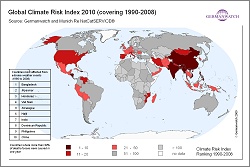 |
| Seeing red. Dark areas on this map (click to enlarge) show both Burma and the U.S. as falling within the top 20 countries at risk (out of roughly 190) from 1990–2008. (Image source: Germanwatch) |
[back to top]
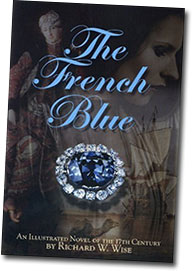 |
Like myself, many people in the gemstone trade have a constant yearning of traveling to exotic mining locations and unearthing that one very special stone. Reading Richard Wise’s The French Blue, however, just might satisfy that urge. From the very beginning this vivid novel reads like the screenplay of a favorite swashbuckling epic, capturing the imagination of your mind’s eye…
The son of the cartographer, Jean-Baptiste Tavernier led a life most of us would envy. During his childhood years, he was able to meet explorers from all points of the world when they paid visits to his father’s shop. While his father documented the coordinates of the exotic and sometimes dangerous places to which the explorers had traveled, Jean-Baptiste listened attentively to the stories each visitor would tell. Armed with the tales he heard as well as the encouragement of his father, Tavernier would head out to see the world in ways most young men of his time could only imagine.
The French Blue gives splendid accounts of the six major voyages taken by Tavernier within the years 1631 and 1669, supplying intricate insight into each journey separately. From Persia, to India, and back to France, Jean-Baptiste Tavernier became arguably the most influential gem merchant of all time.
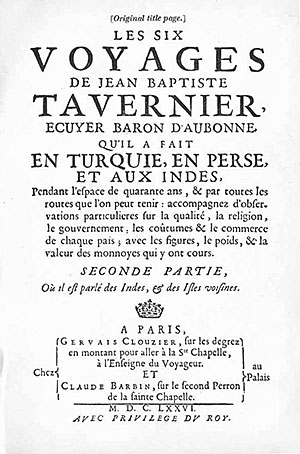 |
The stone moves through history: stolen, bought, recut and renamed “The French Blue,” then stolen again, sold again, and ultimately recut one last time, and renamed once more, as “The Hope Diamond.” From the time of the stone’s curious acquisition, the tale of the 116-carat intensely colored “Tavernier Blue” has been and will be shrouded in a certain amount of mystery.
During his voyages, the decisions Tavernier made would mold his entire life. Without his sense of spirit and adventure, the existence of such an amazing stone may never have been brought to the attention of the Western world (and, ultimately, to its present home, the Smithsonian).
Richard Wise is a terrific storyteller, and like his subject, he’s undaunted by a challenge, even if it concerns the most famous gemstone in history. This book is a great Holiday gift for anyone who never knew the “whole story.” I enjoyed it a lot and I trust you will, too.
For more information, visit TheFrenchBlue.com. [back to top]
 |
We received a note last week from Rui Galopim de Carvalho, of Portugal’s LabGem, regarding our last month’s featured topazes. But it was the attachment he sent that caught our eye: Portugal Gemas, the lab’s e-newsletter, with a cover article on Diamantes Azuis—blue diamonds.
Other articles contained in this handsomely produced e-zine:
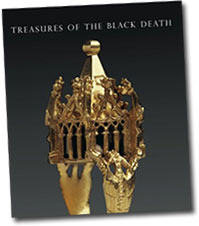 |
| Portrayed on the book cover, from a show at London’s Wallace Collection, is a Jewish wedding ring—that rings, as can be seen (and heard) in this video. |
Of course, you’ll have to brush up on your Portuguese, or use a translation service like Babel Fish. [back to top]
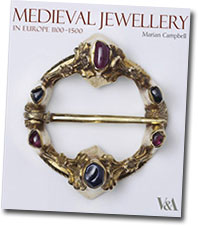 |
Not long after we announced its exhibit “Maharaja: The Splendor of India’s Courts,” the Victoria and Albert Museum issued the monograph Medieval Jewellery in Europe 1100–1500, by Marian Campbell. The book focuses on a subset of the V&A’s impressive, larger collection that covers Classical times to the present.
The slim, 112-page volume contains 90 color images and includes “contemporary portraits and sculpture to place the jewellery in its cultural context,” according to this entry at the museum shop.
Marian Campbell is a Senior Curator of Metalwork in the Department of Sculpture, Metalwork, Ceramics and Glass at the V&A. She has lectured in major museums in Europe and America, and written widely on metalwork of all periods. She is author of Introduction to Medieval Enamels (1983), and Decorative Ironwork (V&A 1997) and a contributor to Gothic: Art for England 1400–1547 (V&A 2003). [back to top]
— End December Newsletter • Published 12/16/09 —
On October 23, Chicago’s Field Museum of natural history unveiled its newly expanded Grainger Hall of Gems, which University of Chicago Press publicist Mark Heineke says “will rival the collection at the Smithsonian in value and sheer breadth.” The Hall of Gems has had several renovations and additions through the years, the last being in 1985. The current refurbishment takes advantage of new lighting technology and “a fresh interpretation of the gems, focusing on their origins and relationships by featuring stones in the matrix, as cut gems, and as jewelry pieces,” according to the museum website.
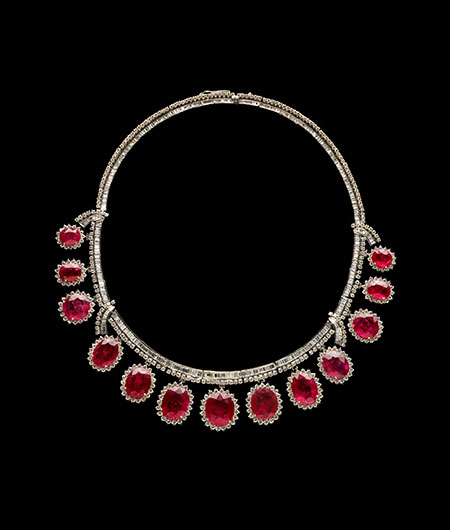 |
| Ruby and diamond necklace. This glittering necklace showcases 13 rubies, totaling 90 carats and hundreds of sparkling round and accent diamonds, set in platinum. (Photo © 2008 The Field Museum) |
The museum originally was founded to house collections assembled for the World’s Columbian Exposition of 1893. That fair’s gemstone exhibition was assembled by Charles Lewis Tiffany’s gem expert, George Frederick Kunz, who 15 years earlier, at the tender age of 21 or 22, had supervised the cutting of the famous yellow diamond that goes by the Tiffany name (and is itself featured in another show at the Field, The Nature of Diamonds). That Exposition’s exhibition became the seed of a collection that now includes more than 600 gemstones and 150 pieces of antique and modern jewelry.
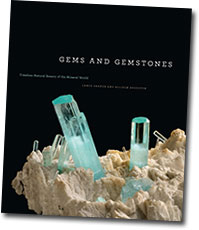 |
That’s the reaction Pala’s Bill Larson had when he laid hands on the new book that documents nearly 300 of the treasures from the Grainger Hall of Gems. Gems and Gemstones: Timeless Natural Beauty of the Mineral World is authored by Lance Grande, head of collections and research at the Field Museum, and Allison Augustyn, a funding specialist at the museum with background in exhibition development there. Writing to one of the authors, Larson said, “I just unpacked it over an hour ago and time evaporated for me.” The book, he continued, “is a fine new reference and necessary for any gem or mineral library.”
Not every museum collection can be the basis for a stand-alone volume that claims to be “the most ambitious publication of its kind,” according to this illustrated brochure. “This lavishly illustrated volume…provides a general introduction to gems and natural gemstones, conveying their timeless beauty and exploring similarities among different species and varieties.”
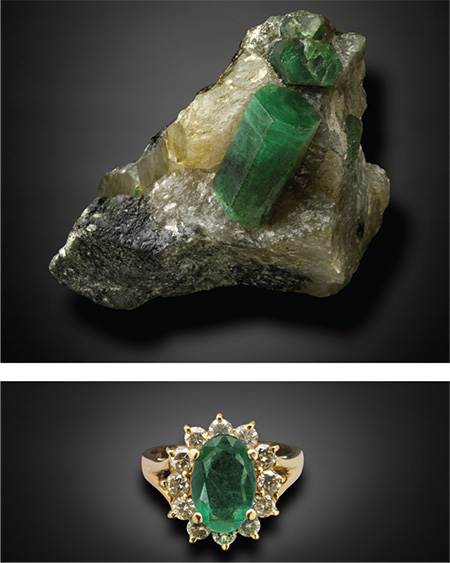 |
| Emerald, cut. Two of the 290 color plates included in Gems and Gemstones. These photographs mirror the Field Museum’s new display design, emphasizing the natural origin of, in this case, emerald. (Photo courtesy University of Chicago Press) |
The book, co-published by the prestigious University of Chicago Press with the Field Museum, is available through the museum’s store and where other fine books are sold. [back to top]
This month we thought we would follow the birthstone trail and take a closer look at some of the colors within the topaz family for the month of November.
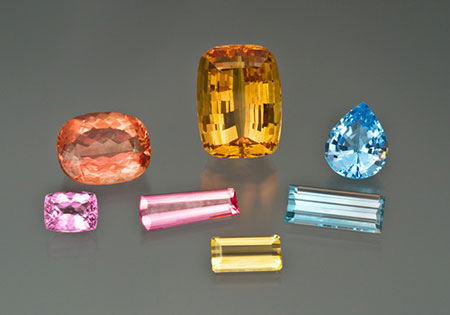 |
| Topaz suite: Pink cushion 4.97 cts. (Inventory #17535), imperial cushion 22.49 cts. (Inventory #17513), rose tapered emerald cut 4.76 cts. (Inventory #17532), golden cushion 53.80 cts. (Inventory #1643), yellow emerald cut 4.11 cts. (Inventory #5070), light blue emerald cut 9.76 cts. (Inventory #8679), blue pear shape 10.74 cts. (not inventoried). (Photo: Mia Dixon) |
From the irradiated blues to the precious pinks, topaz can be an economical source of color for a neophyte, or a prize for the advanced collector. All the controversy of irradiated blues has surely softened that market, but many people are still enticed by the neon blue hues. Imperial topaz from the golden to red hues still are exclusive to a few mines in the Minas Gerais region of Brazil. As the supply seems fairly low but steady, and the demand keeps rising, it’s harder to match stones with collectors, causing prices to continue their ascent.
And if we refer to Kensho Okamoto’s table, listed below, we find that the topaz family helps to calm down, and cheer up, the mind. We all could use a taste of that medicine.
Interested? Select the inventory numbers above, call, or email us to inquire. [back to top]
Pala International received a very special visitor from Japan a couple of weeks ago: a man who recombines aspects of the gem world that have been separated by most in recent times. His unique philosophy entails tuning into specific “wave motion” whereby one can grasp the harmony between one’s body and that of a given gemstone to open up energy flow and heal spontaneously. Kensho Okamoto describes the blockage of a healthy circulation of energy due to environmental factors such as the toxicity of chemicals ingested into our bodies as well as the toxicity of negative media and people on our minds. Engaging in today’s chaotic world, says Mr. Okamoto, creates imbalance, while tapping into the healing properties of gemstones can actually reawaken one’s energy chakras and allow a harmonious state of well being. From the 1400s to the 1600s, a similar edict was synonymous with gemstones’ powers. You can find numerous references to metaphysical properties of gemstones written in the medieval lapidaries published during that time.
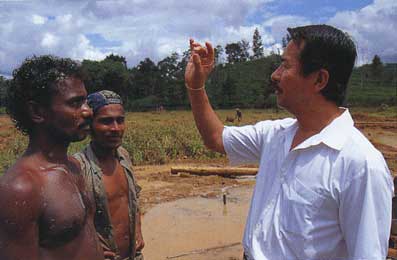 |
| Mr. Okamoto seen analyzing some sapphire rough in Sri Lanka. (Photo courtesy Kensho Okamoto) |
Mr. Okamoto has not only theorized and alluded to the process but has used the scientific method to generate quantifiable results for the non-believers. During his recent lecture at the Gemological Institute of America in Carlsbad, he even went so far as to demonstrate to his audience the effects of gemstones on the body—and on something quintessentially Californian: a glass of wine. Mr. Okamoto began by selecting a species of gem to match the “frequency” of a student volunteer in order to create sympathetic “wave motion.” The energy was then transmitted through the student’s body and into the wine glass, exciting the little wine molecules to actually shift the taste. Fellow students sampled the wine and definitely tasted the difference, becoming believers first-hand. Gemstone energy also seemed to cure a few aching necks and backs by using the appropriate gem to stimulate the problem areas.
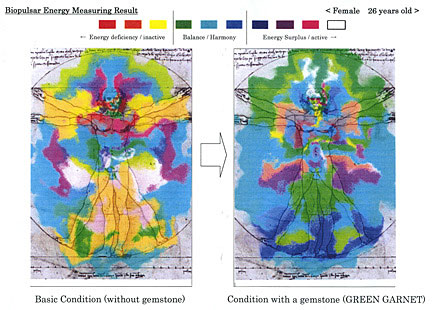 |
| Green garnet is used by a 26-year-old woman to modify her biopulsar energy indicators that were initially measured as deficient/inactive (shown as yellow and orange areas), pushing them into the balance/harmony end of the spectrum (shown as greens and blues), according to Mr. Okamoto. (Image courtesy Kensho Okamoto) |
Mr. Okamoto has consolidated his findings into an detailed table that matches ailments to their appropriate gemstone (view the full table here).
 |
| Mr. Okamoto's table, listing physical and mental aspects on the left, with corresponding gemstones, purported to influence those aspects, listed at the top. View the full table here. |
Mr. Okamoto is president of Ryokusei Japan Group, which is grounded in fine gems and jewelry manufacturing, with offices in Japan, Sri Lanka, and Hong Kong. [back to top]
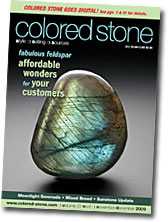 |
In its last hard-copy edition before going digital, Colored Stone’s editor-in-chief David Federman and crew devote the bulk of its editorial pages to feldspar, the group of silicate minerals that includes various appellations such as sunstone and moonstone. “The world may not be paved with diamonds, but it is paved with feldspar,” begins one article in this “focus on feldspar,” alluding to its prominence in the earth’s crust.
Starting out with unakite (pink orthoclase feldspar, green epidote, and clear quartz), the discussion moves on to moonstone (including Sri Lankan blues and Indian rainbows). Dr. Joel Arem looks at the chemistry of feldspar: plagioclase in a compositional range from Ca to Na, and alkali from Na to K. “In terms of variety, including colors, optical effects, and textures, [feldspar] is unrivaled in the gemstone world,” Arem concludes, and the attractive photos that attend the text make that abundantly clear.
If one needed more convincing, managing editor Karla Rosenbusch profiles the work of three jewelry designers who incorporate feldspar into their work. Federman rounds it out with an overview of natural sunstone from Oregon, which avoided the diffusion-treatment controversy of its Chinese and Mexican cousins in recent years.
Colored Stone will start its twenty-third volume in January with an all-digital, biweekly format. [back to top]
 |
| Moonstone. An example of blue sheen, 39.28 carats, from Burma, Inventory #13258. (Photo: Wimon Manorotkul) |
In Mixed Bag we look at a couple of curiosities…
Editor’s Note: This story was revised for accuracy on 7/28/10 after consultation with Antoinette Matlins.
Earlier this month, the ABC television show “Good Morning America” (GMA) discussed the relatively new issue of lead-glass-filled rubies. GMA went department-store shopping for rubies with expert and author Antoinette Matlins. The three ruby pieces purchased by Matlins from three different Macy’s stores were confirmed by American Gemological Laboratories (AGL) to be composite rubies, a term applied to ruby rough that has been cleaned of non-ruby material, resulting in a fragile, sponge-like, multiple-crystal structure that is then fused with lead glass, and faceted. The department stores’ posted disclosure notices omitted this type of filling from the list of possible enhancements.
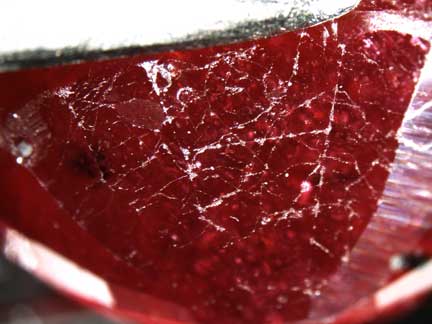 |
| Failed filling. Damage to glass filling can be readily apparent. (Photo: Christopher P. Smith, AGL from our 2007 story) |
While gemologists will routinely examine a stone for filling, an unwitting consumer could damage such a stone. “Lemon juice or common household cleaners can also damage composite rubies,” the GMA web and video story noted.
Pala international has been reporting on these lead-glass-filled rubies as they have worked their way into the marketplace (view our December 2007 and December 2008 stories). This most recent misrepresentation by department stores exhibits the lack of knowledge about evolving gemstone treatments and the importance of having well-trained gemologists to be current in their charge to recognize treatments. [back to top]
Last April, the British tabloid Daily Mail featured a headline on the “curse” of a £15 million, 10,000-carat stone, dubbed the “Gem of Tanzania,” accompanied by the garish image of a faceted red stone so big it crowds the edges of its frame. The story’s plot, we’re told, includes “the Crown Jewellers, an African coup, diamond smuggling and a Hollywood star.”
Last month, a different sort of tabloid, The Independent of London, amongst others, crashed the party with its own headline: “The ‘£11m Gem of Tanzania’ exposed as a £100 fake.” And its own photo—of a pinkish-purple rough gemstone specimen. A David Unwin of Wrekin Construction (we’re not making this up, folks) acquired the specimen in a land deal from a property developer who had documents that valued the specimen at £300,000. Upon its bankruptcy in March, however, Wrekin listed the gem at £11 million—the firm’s largest asset.
A Wrekin annual report claimed valuation was performed on August 31, 2007 by the Instituto [sic] Gemmologico Italiano in Valenza. Problem is, the Istituto was closed that day, during its annual month-long holiday. On March 17, the UK construction magazine Building ran the transcript of a conversation with Dr. Loredana Prosperi, who stated that the school’s lab issues only certificates (not valuations), that the school’s Valenza school has no lab at all, and that it has no British clients.
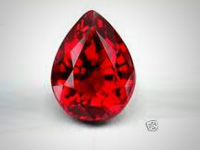 |
| Gem from Tanzania offered on eBay? (Source: eBay) |
Both Building and CNBC ran photos of a pear-shaped faceted gemstone to accompany their stories on March 18 and October 2, respectively. The image (at right) apparently came from an eBay auction described in the Building item, possibly confusing “a gem from Tanzania” with “the Gem of Tanzania.” The Mail ran the same photo on March 21, claiming it was a file photo of a stone “such as” the one “thought to be worth £11 million.”
Confusion may stem from the fact that an image of the gem was unavailable in the immediate aftermath of the announcement of the Wrekin, er…, collapse, as reported March 23 by the construction industry periodical Contract Journal. (View an nicely representational photograph of the specimen here.)
On March 27, the Financial Times traced the stone’s history, which was discovered in northern Tanzania in 2002 and originally sold for £13,000. Six months later, on September 30, administrators for the defunct Wrekin announced that the specimen would be listed in Rock ’n’ Gem, a collectors quarterly. (You’ll also see an advert for the specimen on page 12 of the current Colored Stone.) It seems that no auction house would touch the thing. That evening, Financial Times reported that the valuation docs acquired by Unwin with the specimen “were denounced as forgeries by the purported valuers,” who also, it appears, estimated the specimen’s current worth: £100.
Only 29 shopping days ’til December 16, by which time your offer on “A loose hexagonal crystal rough with co-existent green/black crystal matrix on its sides, opaque reddish purple in colour” must be received at the British liquidator GVA Grimley. Accompanying the sale notice, for your review, is a mineral specimen report issued by Gem-A in 2005. [back to top]
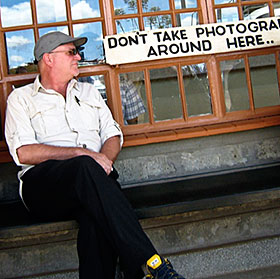 |
Last week, the Accredited Gemologists Association (AGA) announced that Richard W. Hughes would be the recipient of its 2010 Antonio C. Bonanno Award For Excellence in Gemology. According to an AGA press release, the award recognizes Hughes’s “efforts in successfully advancing the profile of many gems and the countries that produce them through his travelogues, as well as more scientific writings and the generous sharing of this information through trade journals and his website www.ruby-sapphire.com.”
The award is to be presented during the AGA’s Tucson Conference in February. Named after the AGA’s founder, the award was created in 2000 “to recognize people who have made significant contributions to the gemological field.” Coincidentally, the issue of Pala’s Gem News you are reading contains news items featuring two past awardees: Antoinette Matlins (2005) and Christopher P. Smith (2009). Smith’s American Gemological Laboratories announced on October 22 its acquisition of the rights to JewelFolio™, the hardbound reports issued for select high-end colored gemstones, originally developed by Hughes at the American Gem Trade Association Gemological Testing Center, which closed last July.
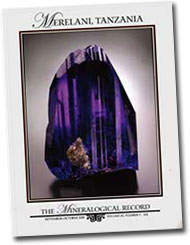 |
Earlier this fall, Hughes and coauthors Vincent Pardieu, Wendell Wilson, and John Saul produced an incredibly comprehensive study of the Merelani tanzanite mines in the Arusha Region of Tanzania. Some of the material and photographs will be familiar to regular readers of Pala’s Gem News, but be assured, that was only the apéritif to the full repas. This 68-page study, in the September–October 2009 issue of Mineralogical Record, is surely the definitive monograph on the subject. [back to top]
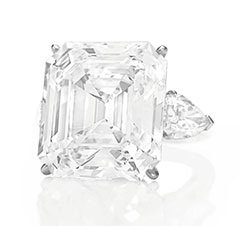 |
| The Annenberg Diamond. (Source: Christie’s press release) |
Christie’s auction house in New York sells a 32.01-carat, square, emerald-cut diamond for $7.7 million over the phone. An unidentified buyer ordered the centerpiece of the Honorable Walter H. Annenbergs’ estate, which was previously bought by the late Leonore Annenberg on her 90th birthday.
This price per carat establishes a new record over the previous 30-carat emerald-cut that was sold for $3.1 million at Christie’s in Geneva back in May.
The big diamond “combines the best of the four C’s: top color, perfect clarity, ideal cut and excellent weight," said François Curiel, international head of Christie’s jewels. [back to top]
Sotheby’s completed Session 3 of its Magnificent Jewels sale yesterday, also in Geneva. Some highlights: A rare ruby-and-diamond necklace, property of Mary, Duchess of Roxburghe, brought four times its upper estimate of just under $1 million. Pictured with the necklace were matching earrings, which brought ten times their upper estimate of about $125,000. A yellow diamond ring squeaked in mid-way between its estimates, at over $3 million, and a fancy blue diamond ring brought $2.5 million. The bargain of the day: a fancy green diamond ring, which came in at 200,000 CHF below its lower estimate of 3.1 million. [back to top]
Two men were charged with the murder of Campbell Bridges, according to a September 17 story by Reuters. The two, Alfred Njiruka and Samuel Masala, had been identified by witnesses during a parade. Njiruka, who had been arrested after the attack last August, was accused of leading the mob that attacked Bridges, his son Bruce, and the rest of their party. He is the leader of a group of small-scale miners in the region where the attack took place.
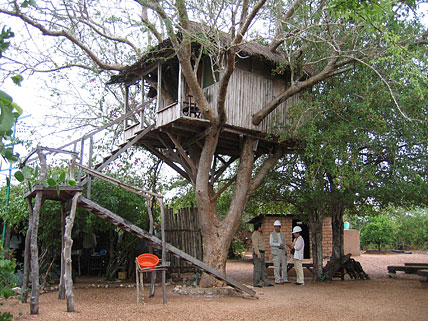 |
| It still stings… The late Campbell Bridges’s tree house at the Scorpion Mine in the Taita Taveta District. (Photo courtesy International Colored Gemstone Association) |
Reuters stated that the two, who pleaded not guilty, were Kenyan nationals, but in a video interview posted by BBC two days following the incident, Bruce Campbell said that the men who killed his father were Somalis. “[T]hey are the same people we have been complaining about for three years,” he told the BBC. [back to top]
In August we noted the 54% drop in Pakistan’s gemstone exports for the 2008–09 fiscal year (July–June), using Average Unit Price statistics, according to the Trade Development Authority of Pakistan (TDAP). Revised October 25 figures for the eleven-month period July 2008–May 2009 show a nearly 58% drop. The first quarter (July–September) of the 2009–10 FY shows a 13% decline over Q1 2008–09.
Gemstones, of course, have taken a back seat to Pakistan’s growing jewelry industry. The revised figures for July 2008–May 2009 show a 24% increase in jewelry exports over the same period in 2007–2008. The Q1 2009–10 figure for jewelry shows a 284% increase over the same period last year.
During the July 2008–May 2009 period, trade in jewelry with the United Arab Emirates increased by 28% while that trade with the U.S. dropped by 14%. The U.A.E. share of total jewelry trade is an enormous 92.5%. During the same period, jewelry increased its market share of Pakistan’s commodities from 1.09% to 1.44%. That same period saw a decrease in Pakistan gemstone trade with both the U.S. (–36%) and U.A.E. (–89%).
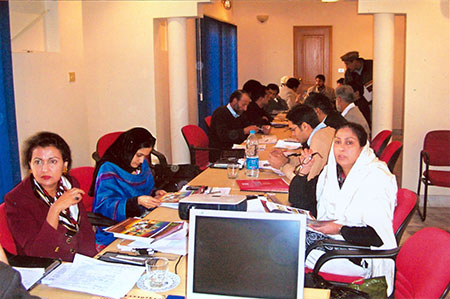 |
| In Islamabad. An intermediate-level course on colored gemstone grading was held in late February at the Geoscience Advance Research Laboratories of Pakistan. (Photo courtesy PGJDC) |
Two other statistics are worth reporting. In our August 2007 report on Pakistan, we quoted a job posting on the Trade Authority of Pakistan website that claimed Pakistan was the eighth largest consumer of gold in the world. That place had shifted to tenth, according to a July 16, 2009 report in Pakistan’s Daily Times, also based on gold consumption.
An October 3 article by Associated Press of Pakistan (APP) quoted a government trade rep as saying $6 million (Rs. 500 million) worth of gemstones per year are extracted from Gilgit-Baltistan, in northeast Pakistan. A gold survey was done in the area in order to spur domestic and foreign investment. The government rep, Tourism and Mineral Department secretary Naib Khan, listed more than a dozen gemstones that are being extracted from the area.
In that same August 2007 report we looked at the Pakistan government Planning Commission’s Annual Plan 2007–08, which listed several challenges to surmount. In the 2009–10 Annual Plan, some of the same issues were listed in an assessment of “constraints and strategic action taken during 2008–09.”
Investment, however, does not seem to be quite the problem it was for 2007–08. Looking forward to 2009–10, according to the report, Rs 1.4 billion ($16.8 million) were being allocated for a development project of the Pakistan Gem and Jewellery Development Company (which was launched in 2007 and whose website now matches its ambitions).
All the non-glamorous minerals, having immense socio-economic benefits would be fully utilized… Dimension stones, precious and semi precious stones industries and other mineral based industries would be developed to meet the ever increasing demand of various sector[s] of [the] economy.
The website includes about 30 notices of training sessions that have taken place over the last two years. Also posted are news items about the numerous local and international trade fairs with Pakistan presence.
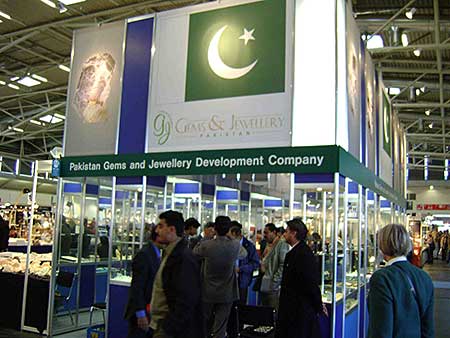 |
| In Munich. Pakistan’s development enterprise attended Mineralientage München this year for the first time—an example of increased marketing efforts. (Photo courtesy PGJDC) |
A year ago, in a September 15 APP story (archived on Google), then-director of the Gem and Gemological Institute of Pakistan Jamshed Khan stated that gems exports could reach $12 billion “if all the stakeholders focus their energies on it.” What once might have been considered merely wishful thinking now seems to have some force behind it. [back to top]
 |
| New pic. Here’s an older stone that Jason Stephenson pulled out last month to photograph for our Old Stock…New Pix feature: a 2.24-carat natural red spinel from Burma with lots of light for a winter night. Inv. #16655. |
Total gemstone production from April–August was down 58% over the same period in 2008, according to figures released earlier this month by the Central Statistical Organization. Rubies were down by 150,000 carats (–15%) and sapphires by more than 500,000 (–68%). Jade production fared better, with a decrease of 18%, or 2.5 million kilos. Pearl production, however, was up by about 300% over 2008.
Trade between China and Burma rose over 26% in calendar-year 2008, according to an October 24 Xinhua story. “China has risen from the 6th position to the 4th in Myanmar's foreign investment line-up,” the story concluded.
 |
| Partly cloudy. How about a gemstone to reflect U.S.–Burma relations? This muted peridot from Burma weighs in at 9.45 carats and has a lovely color. Inventory #5017. (Photo: Wimon Manorotkul) |
 |
Author and jeweler Richard W. Wise has published a second book, but it’s not really a follow-up to his Secrets of the Gem Trade. The French Blue is an historical novel based on the life of merchant Jean-Baptiste Tavernier, who published accounts of his voyages in the 1670s. During those travels, he acquired a 112-carat blue diamond, likely in India, and sold it to Louis XIV for a tidy—but, according to Wise, possibly low-ball—sum in 1689. Wise’s analysis of the political machinations in the court of the Sun King are woven into the book’s fictive account of a tale seemingly familiar to students of storied gemstones, yet nonetheless puzzling when certain questions are considered, as Wise does.
Next month, we’ll feature a full review of the book. For more information, visit TheFrenchBlue.com. For a cable television interview of Wise as he discusses the book, see Spirit of the Berkshires. [back to top]
The current issue of Gems & Gemology includes an article that examines the relationship between the 17th century line-drawing of the Tavernier Blue and a computer model of the lead mock-up of the gemstone, discovered nearly two years ago. Scott D. Sucher, author of this study as well as a prior analysis of the Koh-i-Noor, specializes in replication of famous diamonds.
Read an abstract of “A Crystallographic Analysis of the Tavernier Blue Diamond.” See also Sucher’s behind-the-scenes account of his work with François Farges and the latter’s discovery of the now-famous lead mold (two of them, actually), which we reported on last December. [back to top]
— End November Newsletter • Published 11/18/09 —
Pala International’s Bill Larson and Will Larson will attend this major gem and mineral show…
This year’s special exhibit is titled “India’s Hidden Natural Treasures” and will include the “Emperor of India,” a 10-kilogram aquamarine crystal from Karur, in the Indian state of Tamilnadu. Also displayed amongst other treasures will be a pure quartz crystal carved in the likeness of Ganesha—the centerpiece of the exhibition space designed in the style of a maharaja’s palace, according to show press releases.
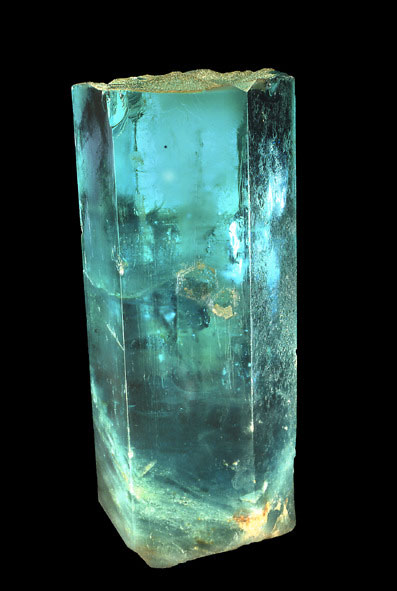 |
| The “Emperor of India” aquamarine is now in the collection of private Italian collector Adalberto Giazotto. (Photo courtesy Mineralientage München) |
The Munich show also features domestic delights—well, nearby, anyway. “Alpine Treasures: From the Mountain to the Display Case” will include 300 minerals from the Tyrol region that straddles the Austria–Italy border. The specimens, drawn from different, mainly private collections from the Naturmuseum Bolzano (Museum of Nature South Tyrol in northern Italy), will be accompanied by several anecdotal explanations of provinence and discovery.
That’s not a crude way of getting a sales associate to leave the break room. It’s the Munich show’s jewelry studio featuring designers and goldsmiths who will create something on the spot, individualized, with no obligation. If you like it, commission it and it’s yours.
Professional crystal hunter Franz von Arx (English translation here) also will be on hand. Last year he co-discovered huge crystals in a cave on the peak of Planggenstock in central Switzerland. Crystals weighing over 350 kilos each will be displayed. (Video stream of the crystals is available from Schweizer Fernsehen.) Natural stone has long been used for wall cladding, but “Natural Objects – Artistically Staged” will examine other creative uses such as backlit salt crystal walls and “stony artworks.”
For more information visit the show website. See the Pala International Show Schedule for future events. [back to top]
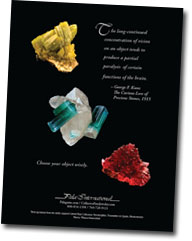 |
| See our ad in this year’s program. |
 |
If the Munich show doesn’t slake the jones for jewels from the subcontinent, hop the Channel and point your sedan chair in the direction of South Kensington, where the Victoria and Albert Museum hosts “Maharaja: The Splendor of India’s Courts.” The exhibition looks anew at the spectacle and substance of provinical rulers during the decline of the Mughal Empire, winding down itself as the principalities are assimilated into the modern states of India and Pakistan. It’s a cultural, as well as cultured, experience, as the museum website explains:
The vision of a king in all his splendour was believed to be auspicious. It was central to the concept of darshan, the propitious act of seeing and being seen by a superior being, whether a god or a king. Although originally a Hindu notion, the idea of darshan became an integral aspect of kingship throughout the subcontinent.
So Bhupinder Singh, who for the first four decades of last century was Maharaja of Patiala, was doing his princely duty when he sat for the portrait above. As the photo suggests, the V&A exhibition includes so much jewelry, it caused Bloomberg News chief art critic Martin Gaylord to wonder whether “you may start to feel that’s enough emeralds and rubies.” Pshaw! [back to top]
This month we feature two truly phenomenal gems.
As our curiosity for the natural wonders of the gem world matures we seem to appreciate truly fine phenomenal more and more. When the unique properties line up to create a show of light and color, we are mystified and enthralled by their beauty. As scientists we wonder how the conditions culminated and what elements coalesced to produce such a colorful and symmetrical gem: the right and left brain blending to an immaculate perception of these interactive jewels.
This jewel combines the best properties one can expect from a star ruby. This stone, which features a truly pigeon’s-blood-red body color and a sharp, well-defined star, is from the Mogok Valley of Burma. It appears as a deep red gem under normal lighting conditions, but when hit by a ray of sun it comes alive.
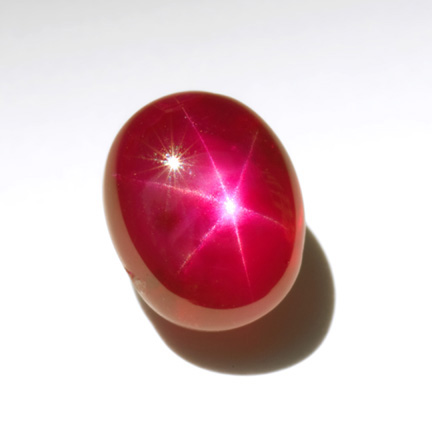 |
| Burmese star ruby. Inventory #16647, 5.18-carat oval cut, 9.82 x 7.92 x 5.87 mm. (Photo: Wimon Manorotkul) |
The second featured stone not only has a distinct eye but the body color glows a warm, golden lime hue. This jewel also exhibits the milk-and-honey effect, and can wink as well. We believe this chrysoberyl comes from the Arusha region in northeastern Tanzania because of its unique electric lime body color and its velvety appearance, but it may be of Sri Lankan origin.
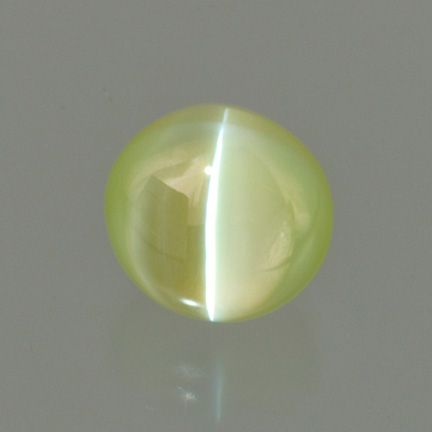 |
| Cat’s eye chrysoberyl. Above, a single light source illuminates the sharp, centered eye with a hint of the milk-and-honey effect. Below, the eye will open and close as two light sources are used, keeping one stationary while rolling the other perpendicular to the eye. A fun trick for any gem lover. Round, 13.25 carats, 12.75 x 7.89 mm. Price upon request. (Photos: Jason Stephenson) |
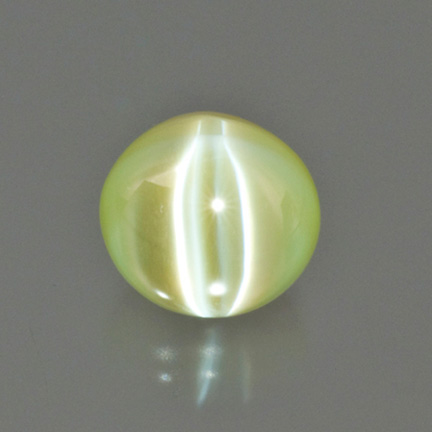 |
Tanzanian spinels hit the market late in 2007 with a bang and have continued to create quite a buzz over the last two years. These pinkish red jewels created a new dimension in hue within spinel’s color palette. The glow or fluorescence of these beauties made them stand out from the crowd, and they seemed to be gobbled up by collectors and connoisseurs fairly quickly. Well, production out of Mahenge, Tanzania, has had another pulse as a few new spinels have trickled into the market again. Who knows how long they will last this time? So if you were considering one, now might be your second—and last—chance.
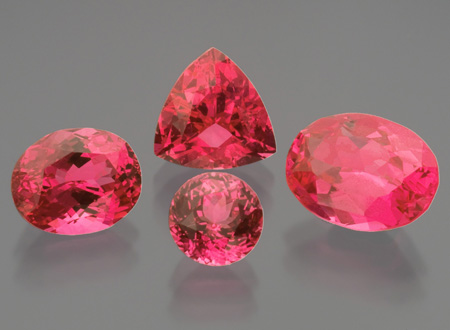 |
| Tanzania Quartet. Spinel from Mahenge, Tanzania, left to right, oval 2.71 carats (Inv #17390), round 1.56 carats (#17387), trillion 2.76 carats (#17389), oval 3.58 carats (#17386). (Photo: Mia Dixon) |
Last month we reported on the Smithsonian’s fêting the 50th anniversary of Henry Winston’s donation of the Hope Diamond to the venerable institution. With a nod to our increasingly interactive age, the general public was invited to choose one of three new settings in which the storied stone will be displayed beginning next spring. The designs all were drafted by the late Winston’s New York jewelry firm. The winner, after more than 100,000 votes: “Embracing Hope.”
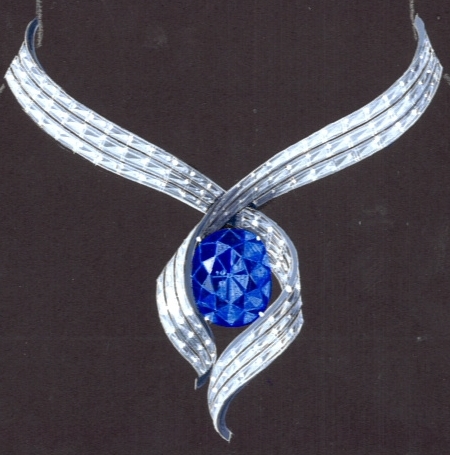 |
| “Embracing Hope,” the winning setting, to be crafted by next spring, until which the Hope will be displayed au naturel. (Illustration courtesy Smithsonian Channel Press Releases) |
As the setting’s designer, Maurice Galli, explains in this video, the surrounding diamond baguettes provide a “cool” contrast to the Hope’s brilliancy and “life.” The asymmetrical form, Galli continues, avoids the setting from appearing “heavy.” After the anniversary’s festivities, the Hope Diamond will be returned to the setting designed by Pierre Cartier. See also Smithsonian.com for more text and video. [back to top]
Conclusive and less conclusive information regarding the issue of red feldspar treatment was released September 9 by several researchers under the auspices of the Gemological Institute of America. Although some of the information has been reported before in bits and snatches, “Special Issue on Red Feldspar” collects it in one place.
At issue is whether feldspar from China has been enhanced to achieve a red color. While colored gemstone aficionados suffering from attention deficit disorder will once again have their patience stretched thin, the issues surrounding red feldspar (aka andesine-labradorite) actually may be an example of scientific rigor at its best: the structured examination of evidence, replication of methodology and results, and deductions that don’t presume too much.
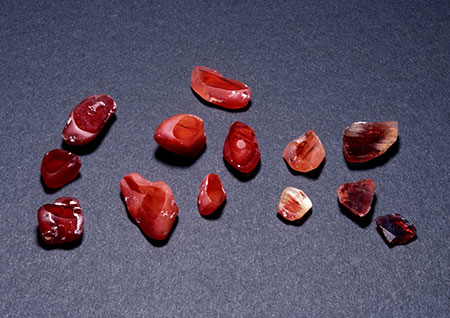 |
| From the source. A selection of rough andesine feldspar, 2.4–34.42 carats, collected from the Bainang mine in Tibet. Ahmadjan Abduriyim explained that they “displayed rounded shapes and a water worn appearance.” (Photo: M. Kobayashi, courtesy GAAJ-ZENHOKYO Laboratory) |
What follows is not a comprehensive digest of the individual reports, but rather a taste of each; anyone interested will want to look at the full special issue. Briefly, feldspar specimens from a mine in Tibet, roughly 100 km. north of the Bhutan border, and from two more in central Inner Mongolia, were personally collected by Ahmadjan Abduriyim of Gemmological Association of All Japan (GAAJ)-ZENHOKYO Laboratory, in October and November of 2008. According to an introductory report subtitled “A Puzzle to Fix,” during his visit to Inner Mongolia, Abduriyim learned of a “new technique” to diffuse copper into colorless material, resulting in red. Prior to that collection, John Emmett and Troy Douthit, of Crystal Chemistry, already had demonstrated that copper could diffuse into colorless plagioclase feldspars from four localities in North America and Mongolia. And while the phenomenology is still under investigation, according to the Crystal Chemistry report included in GIA’s special issue, “the diffusion is rapid enough that an economic commercial process could have been easily developed.”
Samples treated by Crystal Chemistry were forwarded to Kamolwan Thirangoon of GIA’s Bangkok lab, who analyzed both heated and diffused material. These samples were compared with Tibetan and Mongolian material received from Abduriyim. While locality was easily delineated from trace element chemistry for the Crystal Chemistry samples, Abduriyim’s material had chemistry too similar to separate the Tibetan from the Mongolian. Copper concentration could not be used by the lab to differentiate between purportedly natural material and samples known to be diffused in the lab. More study needed.
Shane McClure of GIA’s Carlsbad lab concluded that material from Mongolia probably was colorless originally, but that “the possibility exists that a Tibetan mine is producing red and green andesine feldspar.” Like Thirangoon, McClure found that the two localities could not be separated chemically. Nevertheless, in his report McClure includes a fascinating mention of a colorless zone that follows the surface of rough material—a zone that is present in both natural and treated samples. Counterintuitively, “in the untreated stones the [colorless] zone contains little or no copper, and in the treated stones there is significant copper content” in the colorless zone. More study needed.
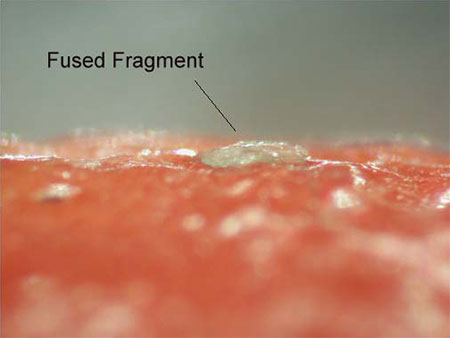 |
| A little something extra. Fused fragments and glass found in surface depressions are indicators of possible high-temperature heating required for diffusion. If the glass analyzes as un-volcanic, suspicion is raised. The example above is from a rough andesine feldspar from Inner Mongolia, included in George Rossman’s interim report. Material from Tibet also displayed fused fragments and glassy material. Hmm… (Photo: George R. Rossman, California Institute of Technology) |
Caltech professor George Rossman’s interim report of an ongoing study includes two graphical representations of chemical fingerprinting, demonstrating the challenge of separating feldspars from Tibet, China, and the Democratic Republic of the Congo. Rossman shows that (re)heating red material from Tibet and Inner Mongolia releases almost no radiogenic argon, in contrast with yellow material that has not been heated. And glassy material found in depressions from purportedly natural red Tibetan material “was rich in potassium and enriched in copper”—an indication of diffusion enhancement—“just like that found in the treated red feldspar from Inner Mongolia.” That the “natural” red material was obtained from a mine visit contradicts the lab results. More study needed.
Abduriyim’s study was successful in separating the Tibetan from the Inner Mongolian material using two trace element combos: Ba/Sr and Ba/Li. A graph included in his report shows clear delineation, and other fingerprinting methods resulted in similar distinctions. A full range of observation, testing, and analysis was performed, and Abduriyim’s report—as are those of the other researchers—is filled with photomicrographs to illustrate the text.
Abduriyim begins his report with a detailed account of the mining at Tibet’s Baining mine and his encounter with his samples. Nevertheless, in an August 21 meeting at GIA Carlsbad, the researchers came to a conclusion: More study needed. The stakeholders agreed to a new expedition to the Tibetan mine—and other mines in the area—with old and new participants being involved. Video of Abduriyim’s visit a year ago was posted last month on the GAAJ website. [back to top]
Earlier this week Robert James of the International School of Gemology sent out a newsletter detailing lab analysis of another sort of feldspar: faceted “East African Ruby Sunstone and Emerald Sunstone.” The gemstones, purchased by ISG on the open market, were set in rings and marketed as untreated, but under immersion revealed a coating of some sort. Some of the coating actually broke away from the stones when they were removed from their settings, having been glued to the prongs. [back to top]
 |
Some research reports of note from recent weeks…
Gemlab on “Lead glass treated star ruby without flash effect”: Researchers looked at treatment that appeared quite natural, with inclusions that could be deceiving, and in the absence of a discernable flash effect (observed by moving a treated stone under magnification).
In the same newsletter, Gemlab discusses why a stone labeled “Santa Maria aquamarine” might be a mistake. “Aquamarine is not the only blue beryl,” as was determined by spectral analysis.
Gemmological Association of All Japan on “Radioactive natural stones,” regarding measurement and, for instance, how several stones of the same material in a necklace could have a combined risk greater than a single stone.
Also from GAAJ, “Natural Omphacite,” which discusses the mineralogical distinctions between this “black jade” and jadeite.
SSEF now includes X-ray microtomography for pearl testing, allowing the lab to scroll through virtual 3-D internal reconstruction of a pearl at a resolution of only a few microns in thickness.
The Australian Gemmologist offers a free on an aspect of naturally occurring radioactivity—associated with opal deposits: “Natural Gamma Radioactivity and Exploration for Precious Opal in Australia.” And Part Three of the journal’s extended tribute to the late Grahame Brown includes Richard W. Hughes’s article on the tanzanite mines of Merelani, Alan Hodgkinson on natural versus synthetic aquamarine, and John Koivula on micro-magma chambers in natural rubies and sapphires. A paper that Brown was to have delivered at a 2007 seminar, entitled “Rare Ivories,” also is included. [back to top]
In Mixed Bag we look at a couple of curiosities…
Mia Dixon, Pala’s in-house photographer, spends a lot of time with individual gemstones. Earlier this month she emailed us:
Ever since I first saw the [Barbadian multi-platinum-certified R&B] artist Rihanna, I’ve been amazed by her eye color. Yesterday it dawned on me they have the same colors in them as a lot of andalusites. Would it be silly to point this out in the newsletter?
Not in Mixed Bag, it wouldn’t. Both Andalusia—site of the original discovery of andalusite—and Barbados have seen centuries of colonization. They’re a link between the Old World and the New (as is Rihanna’s music). And, of course, both andalusite and Rihanna’s hazel-colored eyes have a natural color-change, making for a lively appearance.
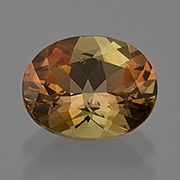  |
Andalusite is remarkably affordable gemstone; for less than the price of Rihanna’s CD catalog you could snap up the 1.79-carat natural Brazilian oval jewel pictured above (Inventory #17657). [back to top]
Just in time for Halloween, a ghostly form passed through Pala’s hands the other day. A true wonder of nature, this Tridacna pearl was produced by the giant clam in the waters off of the Philippines. The giant clam pearl measures 6 x 5 x 5 inches and is the second largest known in existence today. This pearl will be auctioned off along with all the wonderful minerals, gems, and jewelry at this winter’s Bonhams & Butterfields auction to be held in Los Angeles on December 6.
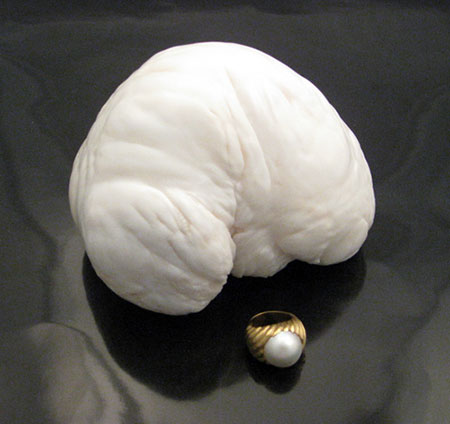 |
| Mighty molluscular. The saltwater host of this portly pearl lives in symbiosis with algae from which it receives nutrition and protection from ultraviolet rays. The clam also may be host to a species of pea crab—if there’s room! For comparison, the ring measures 15 mm. (Photo: Jason Stephenson) |
This oddity of the sea is a 5-pound non-nacreous pearl extracted from a giant sea clam. The white gnarl takes on a high luster and features an abstract shape reminiscent of a brain or vanilla ice creap scoop. Pearls featuring this concretion of non-nacreous material have been referred to as calcareous. [back to top]
A 507-carat colorless diamond is nothing to sneeze at, even through a miner’s respirator. But add to that three other crystals from the same production run, weighing 168, 58.5, and 53.3 carats, and, well, you wonder whether Superman might not have relocated from Gotham to Pretoria. The 100-gram crystal was discovered September 24 at the Cullinan mine operated by Petra Diamonds, according to Mining Weekly. Der Spiegel has posted video that catches it from all the angles.
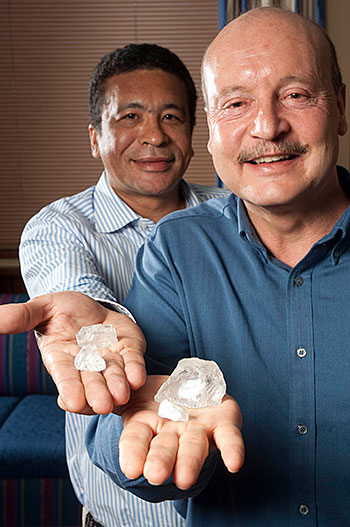 |
| Pretoria Quartet. Petra CEO Johan Dippenaar (right) and Thembinkosi Mining Investments chair Clyde Johnson hold the recently mined rough diamonds from the Cullinan mine in South Africa. Johnson’s firm is a partner in the government’s broad based black economic empowerment policy aimed at correcting past industrial imbalances in the country. (Photo courtesy Petra Diamonds/Buchanan Communications) |
The famous Cullinan mine has been producing enormous diamonds for over a century (with a 20-year gap during the Great Depression). According to Mindat, the hosting kimberlite pipe has a cross-section of 32 hectares at the surface, so the best may be yet to come. [back to top]
We’re pleased to forward the following market report from dealer and author Ronald Ringsrud.
 |
| Manly, yes, but I like it, too… (We couldn’t resist stealing that tagline from the old TV soap ad.) This 3.5-ct. deep green emerald hails from the other side of the global south: Zambia. Inventory #588. (Photo: Jason Stephenson) |
Mid-September in Bogotá, Colombia’s emerald market at 7th and Jimenez was lively and dynamic; dealers, cutters, and exporters were getting ready for the Hong Kong show with the biggest and finest emerald parcels. The September Hong Kong show (along with Basel every April, and Tucson every February) is one of the biggest barometers for the colored stone industry. Big-name buyers were seen walking around every building, but only early morning and after 6 p.m.; the rest of the time they were at desks in the buying offices, viewing the best that the “comisionistas” or brokers could bring around. In one office there was, laid out in perfect rows, a 3000-carat parcel of almost a thousand stones. Such a layout represents countless hours of cutting, polishing and sorting. Another office revealed a set of four stones averaging 12 carats each, for an astounding $20,000 per carat. Amazingly, it is the finest stones that seem to sell quickest. Rarity, among professionals, is instantly recognized. Both of the above selections sold the week before the Hong Kong show.
Now, results are starting to be reported on from those returning from Hong Kong, and emerald dealers are reporting that sales were slow. Anticipation was for strong sales, similar to what was experienced in and after Tucson and Basel 2009. However, what sold in abundance were emeralds up to $500 per carat. Middle quality sold slowly or not at all and fine goods were quiet. A scenario like this one occurred only once in the last four years and it is hard to explain in a normal cause-and-effect manner, except to blame it on the recession.
So the Colombians who sold in Bogotá before the show are happy, but those who expected to sell in China were disappointed. The U.S. market seems mixed with many calls for emeralds and steady sales. Buyers are not buying for inventory, however.
Emerald Prices: With the U.S. Dollar at a low against the Colombian Peso (1:1910—down 10% from 2010 last month), and the emerald still maintaining its per carat prices at pre-recession levels, emerald prices remain strong even in a downturn in demand.
Editor’s Note: Since the above report was filed ten days ago, the Dollar has dropped further, to about 1:1840… [back to top]
It had to happen. Read all about a motion picture being pitched with the notorious “Bahia” Emerald as its central character—in this month’s Mineral News from Pala International.
And Ron Ringsrud points us to another “true story” emerald movie, Emerald Cowboy, which stars real-life Japanese emerald magnate Eishy Hayata, who was quite an exporter during the 1980s. We’ve seen the trailer and… Be afraid. Be very afraid. [back to top]
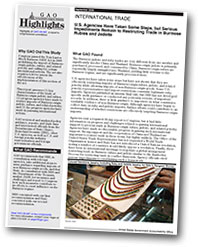 |
The United States Government Accountability Office issued a report September 30 regarding the effectiveness of the Tom Lantos Block Burmese JADE Act of 2008. Two paragraphs from the summary (emphasis ours):
U.S. agencies have taken some steps but have not shown that they are effectively restricting imports of Burmese-origin rubies, jadeite, and related jewelry while allowing imports of non-Burmese-origin goods. Some U.S. jewelry representatives said import restrictions constrain legitimate ruby imports. Agencies published an interim final rule, but DHS has not developed specific audit guidance or conducted any postentry reviews of importers’ records. In addition, there is little guidance to importers on what constitutes verifiable evidence of non-Burmese-origin. Although agencies have begun to collect data on ruby and jadeite imports, further efforts could contribute to an understanding of whether restrictions are effectively targeting Burmese-origin imports.
Agencies sent a required 60-day report to Congress, but it had little information on progress and challenges related to gaining international support to prevent trade in Burmese-origin rubies, jadeite, and related jewelry. Agencies have made no discernible progress in gaining such international support. Strong support and the cooperation of China and Thailand are important to restrict trade in these items, but highly unlikely. The Office of the United States Trade Representative has not requested a World Trade Organization waiver and State has not introduced a United Nations resolution, noting a number of countries would likely oppose a resolution. Finally, there have been no international meetings to negotiate a global arrangement restricting trade in Burmese rubies and jadeite similar to the Kimberley Process for restricting trade in conflict diamonds. Agency officials cited serious impediments to establishing such a framework.
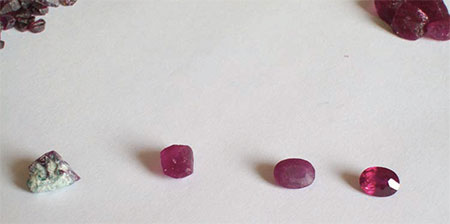 |
| Value added. Thai officials told the GAO “that the value of a rough ruby is only 10 percent of the value of an average piece of finished Thai ruby jewelry exported to the United States. The rest is Thai value-added processing.” (Photo: GAO) |
The GAO recommendations summary:
GAO recommends that [Department of Homeland Security], in consultation with relevant agencies, take additional steps to issue guidance regarding imports of non-Burmese-origin goods, and that State, in consultation with DHS and the Department of the Treasury, analyze JADE Act measures and challenges and report to Congress how such measures contribute to its efforts to exert influence on the Burmese regime.
Other information was gleaned from the text of the full report:
Thai jewelry industry representatives stated that from October to December 2008, Thai jewelry exports to the United States, on average, declined by 30 percent. Moreover, they stated that roughly 1.2 million Thais worked in the jewelry industry in October 2008 and estimated that 100,000 to 120,000 jewelry industry jobs had been lost by March 2009.
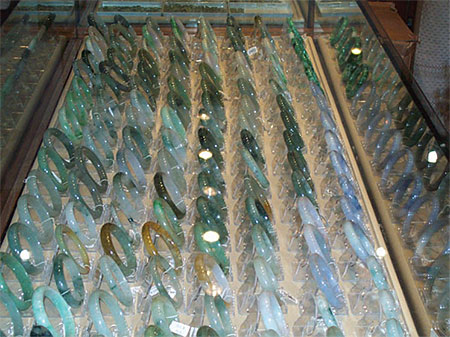 |
| There’s more where these came from. According to the latest statistics, for January through July, Burma jade production in 2009 exactly matches that of 2008—about 19.5 million kilos—up 4 million kilos from the same period in 2007. (Photo: GAO) |
Anecdotal information also was included.
Some representatives of the U.S. and foreign jewelry industries we interviewed also expressed concern about U.S. import restrictions under the JADE Act. They said that U.S. import restrictions have little impact on the military regime in Burma and negatively impact small-scale miners and traders in Burma and jewelry workers in Thailand. According to jewelry industry representatives, as a result of the act, some U.S. dealers have become reluctant to deal in rubies, jadeite, and related jewelry whether or not they were from Burma. Although the import restrictions in the JADE Act allow trade in non-Burmese-origin rubies, jadeite, and related jewelry, some industry representatives said that the restrictions imposed by the act have reduced trade in rubies overall, not just trade in Burmese rubies. For example, one gemological lab director noted that since the inception of the law, few dealers have submitted rubies for testing, suggesting that dealers are less inclined to trade in rubies overall.
Some representatives of colored gemstone dealers expressed concern that CBP agents may not have the ability to differentiate between Burmese and non-Burmese rubies, jadeite, or related jewelry and this could lead to wrongful seizures. For example, a ruby dealer we met with said he wanted to purchase a 5-carat, reportedly non-Burmese, ruby during an overseas trip. The dealer paid a gemological laboratory to have the stone tested for a country-of-origin determination. However, he decided not to purchase the ruby because (1) as a result of testing, the stone was judged as originating from one of six possible countries, one of which was Burma, and (2) with no way to definitively prove the stone was not from Burma, the dealer was concerned CBP officials might mistakenly or arbitrarily seize the stone.
As we’ve noted before, vigorous activity surrounding the 2008 legislation does not appear to be high on the priority list of the Obama legislation. But movement regarding Burma is taking place…
“US hopeful after first talks with Myanmar” was the somewhat ironic headline from The Myanmar Times last week, regarding Assistant Secretary of State Kurt Campbell’s meeting with a delegation from Burma. Campbell, for his part, has been playing up Burma’s own initiative regarding the commencement of dialogue. “For the first time in memory, the Burmese leadership has shown an interest in engaging with the United States,” he told a September 28 press conference gathering prior to the meeting.
The same Myanmar Times article noted a visit to Burma in mid-August by Virginia U.S. Senator Jim Webb, during which he met with Senior General Than Shwe. Webb’s visit was the first to Burma by a member of Congress in over ten years. Webb then met with Burmese Prime Minister Thein Sein at the United Nations the same day as Campbell’s press conference. Webb chairs the East Asia and Pacific Affairs Subcommittee of the committee on foreign relations.
Two days before, the New York Times published an editorial by Webb. With his August trip as backdrop, Webb wrote about the people of Burma: “They are so hardened after decades of civil war and political stalemate that only an even-handed interlocutor can lift them out of the calcified intransigence that has damaged their lives and threatened the stability of Southeast Asia.” It may have been ten years since such subtlety was uttered by someone in a position to do something about it. [back to top]
— End October Newsletter • Published 10/19/09 —
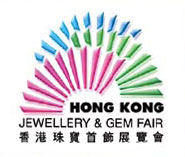 |
Pala’s Gabrièl Mattice, and The Collector Fine Jewelry’s Jeanne Larson will attend this fall’s largest international jewelry fair in Asia. This year’s show inaugurates “a clear product sectorisation” between the two venues, according to the event website:
A press release states that this year’s fair is “20 percent bigger than last year in terms of exhibition size.” The expanded size, with nearly 3,000 exhibitors from 44 countries, makes “this year’s edition the biggest thus far in the world”—remarkable in the face of economic conditions that have seen a decline in the number of exhibitors at many venues.
A Fine Gem Pavilion will debut this year.
Located in Hall 9 of the AsiaWorld-Expo, the pavilion features about 50 esteemed suppliers from 13 countries and regions offering top-quality diamonds, gemstones and pearls. Exhibitors come from Austria, Belgium, France, Germany, Hong Kong, India, Israel, Italy, Japan, Sri Lanka, Switzerland, Thailand and the United States.
The fair will include almost 300 exhibitors from Thailand, nearly 170 from Italy, 120 each from India and the U.S., and first-time group pavilions from Colombia, Malaysia, the Philippines, and Shenzhen, China. The full list is available here. [back to top]
This month we had a power struggle amongst contenders for Pala’s featured gemstone. The victor was a late entry, but it easily eclipsed the competiion. We are pleased to present for September a substantial (not the least due to its weight of 152.47 carats), purportedly-natural red zircon from Tanzania.
Bill Larson gives us the background:
This is the largest fine red zircon I have ever seen. It is said to be from newly mined material in Tanzania and unenhanced. But note: Pala has not certified this gem with GIA yet. It was shown directly from a master Thai cutter through a friendly, serious gem dealer in Bangkok before he had even purchased the gem. We did an immediate negotiation, and Pala owns said gemstone.
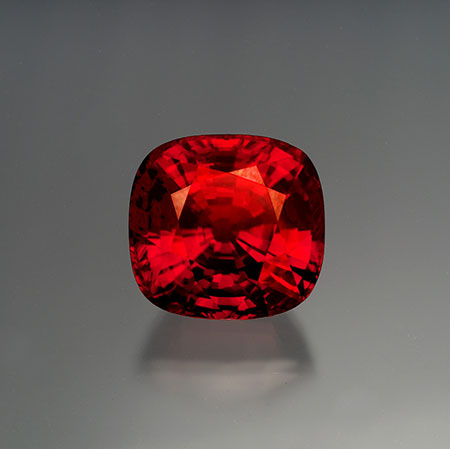 |
| Super-sized. Orangy-red zircon from Tanzania, 152.47 carats, 26.1 x 25.9 x 20.1 mm. (Photo: MIa Dixon) |
In the sun this zircon glows like a red coal. A slight orange secondary color makes it superbly beautiful. In artificial light it glows red. This is a museum-quality gem.
Here’s a twist on your standard pearls…faceted pearls, also known as “flower pearls.” There is a selection of cultured pearls that retain certain properties that lend themselves to be faceted. To facet a pearl you must start with a high quality product, such as a Japanese Akoya white, a Tahitian black, or South Sea golden. Precision faceting must be done by hand to create the flower symmetry and bring out the scintillation.
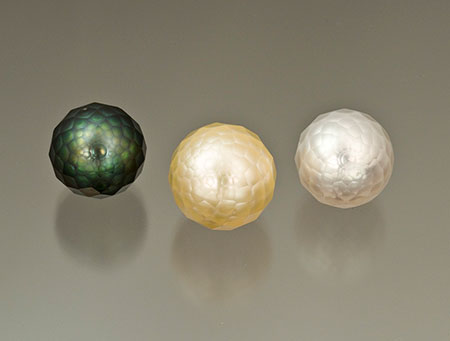 |
| Award-winning. Tahitian black, 14.5 mm., 22.56 carats; South Sea golden 16 mm., 30.04 carats, and the Akoya white, 15 mm., 24.13 carats. See this hi-res version. (Photo: Jason Stephenson) |
Pearls to be faceted require a minimum growth period of two years in which the nacre must reach a certain thickness to accommodate the facet arrangement without breaking through to the nucleus. The pearl material must also be relatively blemish-free because blemishes cause weakness in the nacre with cutting and become more visible when under a high polish.
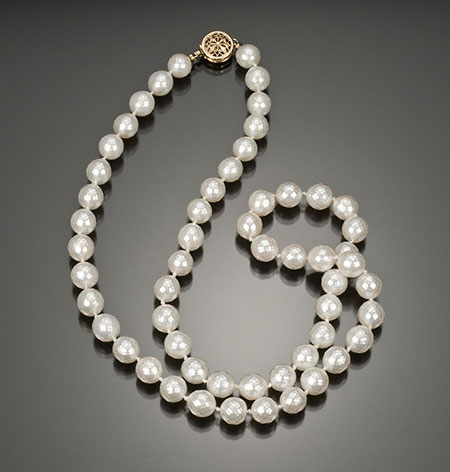 |
| Do the strand. This necklace features 19 inches of 7-mm. faceted pearls and a 14-carat gold clasp. Available from Collector Fine Jewelry. (Photo: MIa Dixon) |
Interested? See this selection from our online catalog. Or call or email us to inquire about our full inventory of faceted pearls.
Kazuhito Komatsu was presented with an Award of Japan for Crafting with his work on developing the faceted pearl. Kazuhito won the most prestigious Prime Minister Award and was presented the award by the man himself, Mr. Aso. The Japanese government gives out awards to special technology in many industries from 600 applicants. Starting in 2005 the award ceremony is held every two years.
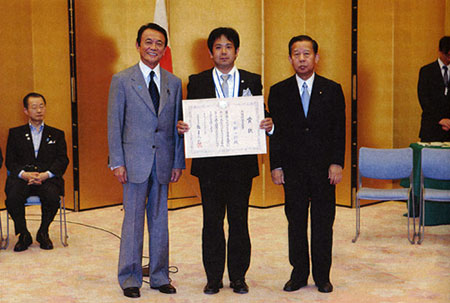 |
| Master faceter Kazuhito Komatsu (center) receives his recognition from Prime Minister Taro Aso (left). |
Pala International has been importing fine-quality faceted pearls from Japan for the last ten years. Kazuhito holds the patent for the innovation and manufacturing techniques of faceted pearls, and he is our exclusive supplier for the material. We congratulate Kazuhito for this most prestigious award. [back to top]
The small quarry in the Eifel Mountains has given up a big haüyne. A 3.72-carat haüyne was recently unearthed near the town of Niedermendig in Germany, and is one of the world’s largest and finest ever found. Pala has been buying a few haüynes every year from the local miners, but this year is unique in having such a fantastic stone revealed. This haüyne is available for sale through Pala. (But you have to be able to pronounce it. Just kidding…)
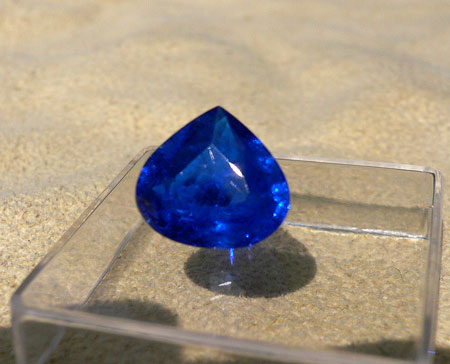 |
| This Haüyne from the Eifel Mountains is remarkable not only for its size, but also its lovely color. (Photo courtesy Klaus Reisdorf) |
Pala’s Bill Larson: “We are going to put this 3.72-carat haüyne up on Palagems.com, €22,000 net! But it is one of the world’s greats.” More background on haüyne is available in our write-up on February’s featured 1.73-carat haüyne. [back to top]
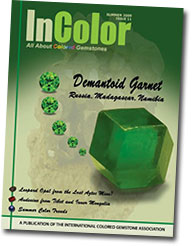 |
Demantoid garnet in Russia is harvested only during the summer months, due to the relatively brief window of weather-wise hospitality of the Ural Mountains. So it’s appropriate that demantoid is cover-girl for the Summer 2009 issue of InColor, the quarterly journal of the International Colored Gemstone Association.
Our Pala pals will recognize the authors of InColor’s feature article on demantoid mining (and more): Jason Stephenson and Nikolai Kouznetsov. Jason—who currently is honeymooning with his new bride in the warmer climes of Tahiti—is a Pala staffer who rarely passes up an opportunity to explore the inner world of colored stones, as exhibited by the photomicrograph below. Nikolai and Pala’s Bill Larson have been visiting mines together in the southern Urals for over a decade.
As revealed by the title, “Major Deposits of Demantoid Around the World,” the article isn’t limited to Russian localities. Also covered are Namibia, Italy, Iran, and Madagascar, as well as imitations, treatments, rarity, size, and market value.
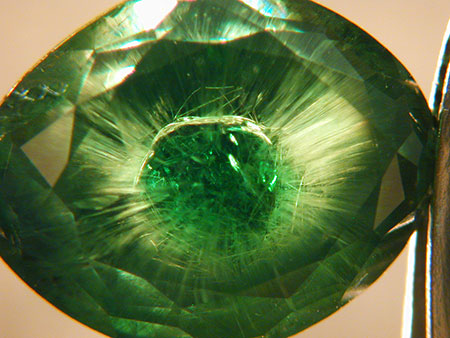 |
| The eye of demantoid. Jason thought this might be good “eye” candy for those gem lovers who like to delve into the microworld: “This 10.32-carat Russian demantoid happened through our office the other day, and we couldn’t help but try to capture the unusual scene within. In the heart of the jewel we find a pure nodule with radiating horsetail fibers, suggesting a two-stage growth of the demantoid crystal, but definitely some complex genesis at work…” (Photo: Jason Stephenson) |
Other articles of note in this InColor (accessible from the link above):
[back to top]
It’s been two years since we tooted our own horn—or rather since we passed along some of the toots (or would that be tweets now?) we’ve received from our readers. Now that Pala is 40 we thought we’d let you read some of what’s come our way. Note: Affiliations are for identification only; they should imply no endorsement by an organization or institution.
 |
Thanks for the nice plug of the latest G&G on Pala’s newsletter! Much appreciated…. Pala’s newsletters are the best electronic newsletters I receive regarding the gem and mineral trade. Keep up the great work! —Brendan Laurs, Editor, Gems & Gemology, in response to our mention last month of G&G at 75
The information provided here is undoubtedly the finest, clearest “Buying Guide” that I have found on the subject of tourmaline. As my wife and I met in Maine, her engagement ring includes a beautiful green tourmaline center stone, surrounded by diamonds. We think it’s gorgeous, but we are surely NOT gemologists. I guess we simply know what we like. —Dave Wexler, in response to our story in January on the Maine tourmaline necklace worn by the state’s first lady Karen Baldacci, to the presidential inaugural events
I want to commend you on your monthly email of mineral news. I read every issue start to finish and always learn new things. You do a great job at combining various articles with diverse subjects. Keep up the good job! —John Betts, of John Betts Fine Minerals, New York
Regarding "Pala’s Hidden Vault,” we quipped, “If you can find it, you are warned, ‘Abandon hope all ye who enter here.’ It’s one hell of a collection! —to which, Sister Elias Freeman writes: Actually, with all due respect, I think the reverse may actually be true, and that your collection may be rather heavenly! The Deity, angels and saints are well-represented, I should imagine, in your august collection, including the various members of the “Celestialite” choir, Angelite and Seraphinite, with their Angels Wings of calcite. And of course there would be various saints like SanJuanite, SanMartinite, SanRomanite, SantaBarbaraite, SantaClaraite, and SantaRosaite, and my favorite Benitoite. Maybe you just need a little more SantaFeite (or “holy faith”)! Of course I wouldn’t expect to find any Atlantean Temple stone or “lemurianite,” but at least you must have Olympite, where the Greek gods used to dwell, or Edenite. But I do wish you all a Happy Saint Valentinite Day! With thanks for such an interesting and informative newsletter…
Dear Bill: Whether the million is in dollars or bahts, I am not prepared to commit, but I would like to thank Pala for all their gem news. Full marks to the crew. I am not sure how I came to be on your list, though it might be due to Ruby Dick, whichever way I am grateful. —Alan Hodgkinson, author of Visual Optics and Gem Testing Techniques
Again, compliments and congratulations on a superb, presentation [regarding our June 2007 Mineral News]. —Lawrence H. Conklin, Mineralogist, who is celebrating his 52nd year as a full-time buyer and seller of mineral specimens
Thank you to Sister Elias Freeman, Dave Wexler, John S. White, and Phyllis J. Hughes for catching our typos!
Be sure to catch the new items in Pala’s Mailbag. [back to top]
The Smithsonian celebrates the 50th anniversary of Harry Winston’s donation of the Hope Diamond by offering the late donor’s firm the chance to give the classic gemstone a facelift—around the edges. Three designs were drafted by the New York jewelry firm’s team, and the public was invited to vote on the favorite, August 19 through September 7. The winner will be announced September 23.
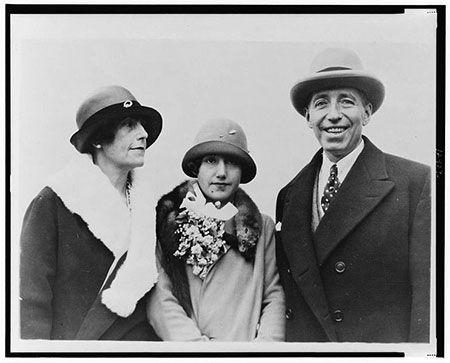 |
| Pierre Cartier, pictured here in 1926 with his wife and daughter, once owned the Hope Diamond, and created its present setting. (Photo: Bain News Service, courtesy Library of Congress) |
The three settings—Renewed Hope, A Journey of Hope, and Embracing Hope—were themselves “finalists” chosen by the Harry Winston team after dozens of sketches. The first two designs were crafted by Maurice Galli, who comes from a family of designers, was trained in France, and is a twenty-year veteran of the firm, having worked with its late founder. The third design was created by Rie Yatsuki.
Beginning this fall, the diamond will be exhibited for a limited time sans setting—for the first time in its history at the Smithsonian. And even the winning setting will be, mm…, set aside, with the fabled jewel returned to its familiar surround in late 2010. For more information, see:
In the coming months we will feature something special on the Hope Diamond. [back to top]
The memorial service for Campbell Bridges was held August 21 at All Saints Cathedral in Nairobi, “attended by family, friends, Kenyan Chamber of Mines members, ICA members, government officials, embassy officials, miners, and members of the gemstone community,” according to the International Colored Gemstone Association. Photographs, a summary of remarks, and video excerpts are available on the ICA website, as well as a poem of tribute by Robert Weldon. A biography of Bridges is available here.
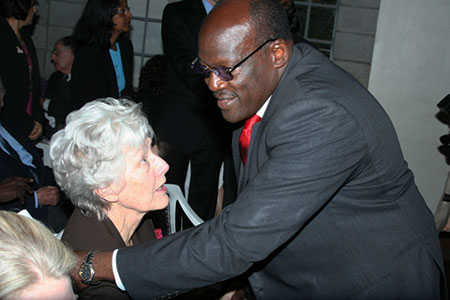 |
| In passing. MP and Deputy Govt. Chief Whip Johnson Muthama embraces Judy Bridges at the memorial service August 21 in Nairobi. (Photo courtesy ICA) |
As of a week ago, according to the Kenyan Daily Nation, two key murder suspects still were at large. As the article notes, the suspects are known to police, but “are still playing hide and seek.” Indeed, Campbell’s son, Bruce Bridges, told the BBC (reported August 13) that the men who attacked his party—Somalis—all were known to him “by first and last names.” As of August 13, six men had been arrested in connection with the murder, according to the Telegraph (UK), with a seventh arrested as of the 19th as he tried to cross the border into Tanzania (BBC).
The dispute with local miners, who Bruce Bridges termed “bandits,” was the subject of a relatively lengthy August 22 Daily Nation article. As of that date the local Officer Commanding Police Division confirmed that “one person suspected to be the leader of the gang that attacked Mr Bridges had been arrested.” The article discusses the difficult balancing act maintained by Bridges, who faced local resentment for his success, nativist politicians who railed against the rule of law that supported Bridges, security risks, and an accusation by the local member of parliament Calist Andrew Mwatela of brutality by Bridges upon discovery of claim jumpers. Challenging this last charge by the MP, the educator R. A. Massie-Blomfield, a friend of Bridges, wrote:
Those of us who knew Campbell Bridges think that such remarks bear no resemblance to the fine, warm-hearted individual who was admired and respected by many.
I only hope the MP was misreported, since he appears to be defending lawlessness, while criticising an honest man, murdered while going about his lawful pursuits.
We all know that matters could have turned out even worse. Had Campbell not been relying on police protection, he would presumably have been armed, in which case he might conceivably have shot his attacker dead, and found himself…on a charge of premeditated murder.
Another MP, Johnson Muthama, himself a member of the International Colored Gemstone Association, attended the memorial service for Bridges. He called upon the authorities—his colleague in government—to improve Kenyan mining laws and security, and to foster respect for the law. [back to top]
Last month we received The Centurion What Jewelers Really Think Newsletter and it contained a letter from jeweler Alfredo Molina, which in turn pointed to an editorial by economist Arthur B. Laffer, who predicts a coming inflationary period that will rival that seen in the late 1970s. Laffer exhumes the specter of the prime at 21.5% and gold jumping from $35 to $850 an ounce. In the version of his letter forwarded by The Centurion, Molina suggested that the savvy investor take a cue from Laffer’s projection, and consider assembling “a collection of your own personal crown jewels” as a safeguard for the purchasing power of generations to come.
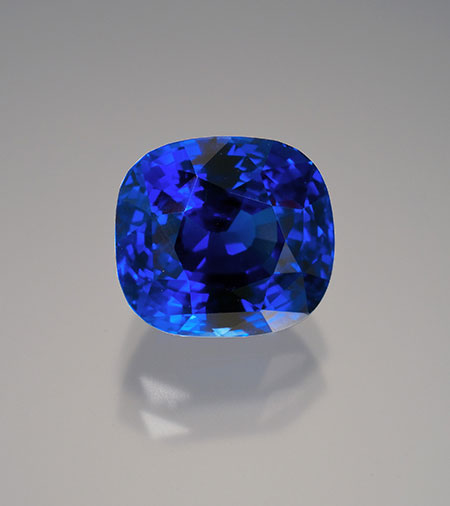 |
| A solid foundation for a crown-jewels collection can be laid with this natural, unheated Sri Lankan blue sapphire. It measures 10.48 x 9.56 x 7.3 mm. and weighs 7.13 carats. Inventory #14737. Doubly certified, including an AGTA GTC JewelFolio™. (Photo: Wimon Manorotkul) |
Arthur B. Laffer is a supply-side economist who made an indelible stamp on the Ronald Reagan administration. In his June 11 Wall Street Journal editorial entitled “Get Ready for Inflation and Higher Interest Rates,” Laffer predicts, well, “rapidly rising prices and much, much higher interest rates over the next four or five years….” Laffer highlights a move last September by the Federal Reserve Bank to put nearly $1 trillion more into circulation, the largest such increase in 50 years. “By such a radical move, the Fed signaled a 180-degree shift in its focus from an anti-inflation position to an anti-deflation position.”
According to the Department of Labor, the consumer price index for the last ten years has fluctuated only 2.2%, from a low of 1.6% to a high last year of 3.8%. So if, as Laffer sets forth, the Fed’s about-face a year ago heralds a return to the double-digit inflation of the 1970s, 2009 could be the ground floor of something big indeed. [back to top]
It’s no secret that Burma has upped the number of domestic gemstone sales, attended by many foreign dealers. Two regularly scheduled sales were mentioned by the official Xinhau News Agency in an August 23 story:
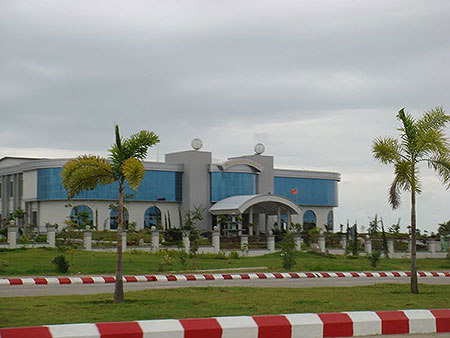 |
| Gems museum in the administrative capital of Burma, Nay Pyi Taw. (Photo courtesy Zaw Htoo Aung) |
What’s less well known is that Burma seeks to expand its market by attending gem shows abroad. A September 13 Xinhua story lists the following shows attended by Burma’s gemstone merchants:
Other efforts:
The article states that Burma’s gem market in Asia “seems to have not been much affected by the global economic downturn as seen by observers[,] as the country’s gems and jewelry stand high in demand among the Asian countries.” [back to top]
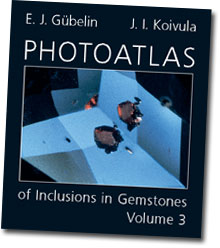 |
Volume 3 of what G&G reviewer Robert E. Kane calls gemology’s “gemstone inclusion bible” was released several months ago, after thirty-five years of “groundbreaking research” by collaborators, the late Eduard Gübelin and John Koivula. The third and final installment of Photoatlas of Inclusions in Gemstones is the culmination of 70 years of inclusion inquisition by Gübelin, and is a milestone in the career of Koivula. Richard W. Hughes, in his own review, calls the pair “[q]uite simply…two of the most prominent gemologists of the past 100 years.”
The series is immediately notable for its “beautifully produced sunbursts of colour,” remarks Alan Jobbins, President Emeritus of the Gemmological Association of Great Britain, but the content also is “scientifically significant.” Hughes underscores the point: “While the Photoatlas volumes superficially masquerade as art tomes, at their heart we must remember they are reference texts.” The series now totals 2,033 pages and over 5,000 photomicrographs. Kane calls it “the most remarkable achievement in the history of gemological literature.”
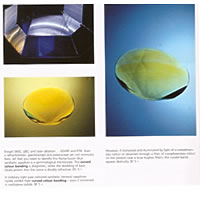 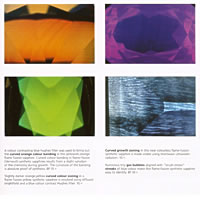 |
| For bootleg sample pages of Photoatlas of Inclusions in Gemstones, Volume 3, visit Richard Hughes’s review of the book on Ruby-Sapphire.com. (Thumbnails courtesy microWorld of Gems) |
Following an introductory section by, appropriately, gemologist Edward Boehm, grandson of Dr. Gübelin, the authors have saved some of the best for last, with major chapters on the big four: diamond, ruby, sapphire, and emerald. Locality detection, enhancements, masquerading all are covered.
The third section covers inclusions in 21 “rare and unusual gems.” Fluorite a bore-ite? Look at these photomicrographs showing the movement of bubbles and daughter crystals in three-phase primary negative crystals. The book contains a glossary of scientific expressions, and each major section includes what Hughes calls “a solid bibliography…a welcome change from previous volumes, which tended to be light on references, in particular.”
Autographed copies of Volume 3—and the previous two—are available from microWorld of Gems. Note: While the website states that Volume 3 is “scheduled for release in 2008,” it is available for purchase now.
See also:
[back to top]
— End September Newsletter • Published 9/15/09 —
2015.3 | 2015.2 | 2015.1
2014.3 | 2014.2 | 2014.1 | 2013.3 | 2013.2 | 2013.1 | 2012.3 | 2012.2 | 2012.1
2011.3 | 2011.2 | 2011.1 | 2010.3 | 2010.2 | 2010.1 | 2009.3 | 2009.2 | 2009.1
2008.3 | 2008.2 | 2008.1 | 2007.3 | 2007.2 | 2007.1 | 2006.3 | 2006.2 | 2006.1
2005 | 2004 | 2003 | 2002 | 2001 | 2000
Note: Palagems.com selects much of its material in the interest of fostering a stimulating discourse on the topics of gems, gemology, and the gemstone industry. Therefore the opinions expressed here are not necessarily those held by the proprietors of Palagems.com. We welcome your feedback.